West Lindsey
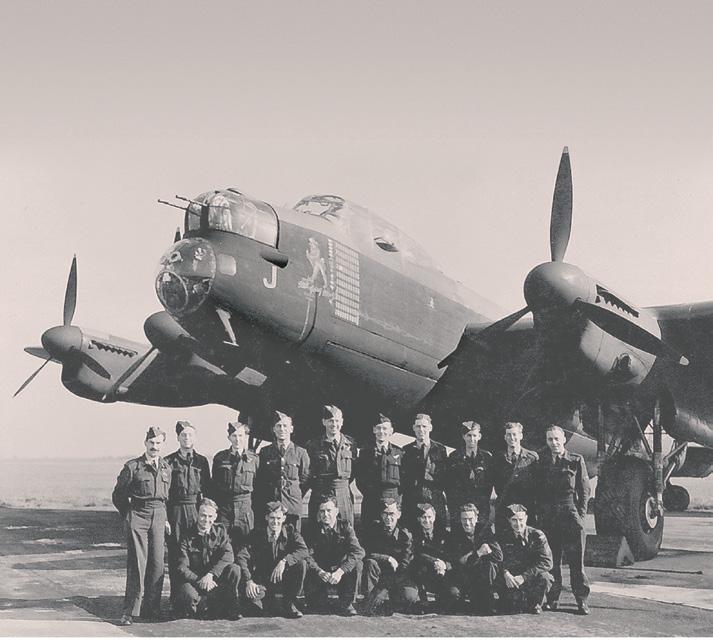

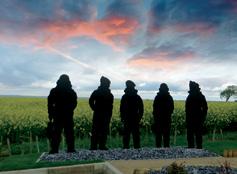
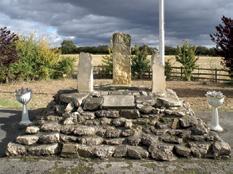
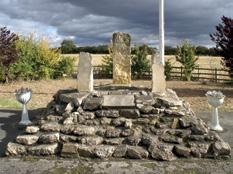
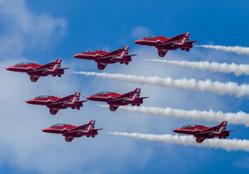
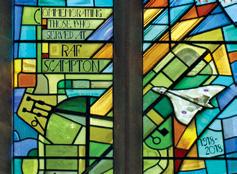
An aviation guide through West Lindsey locating former airfield sites and memorials
aviation guide active RAF stations and former airfield sites


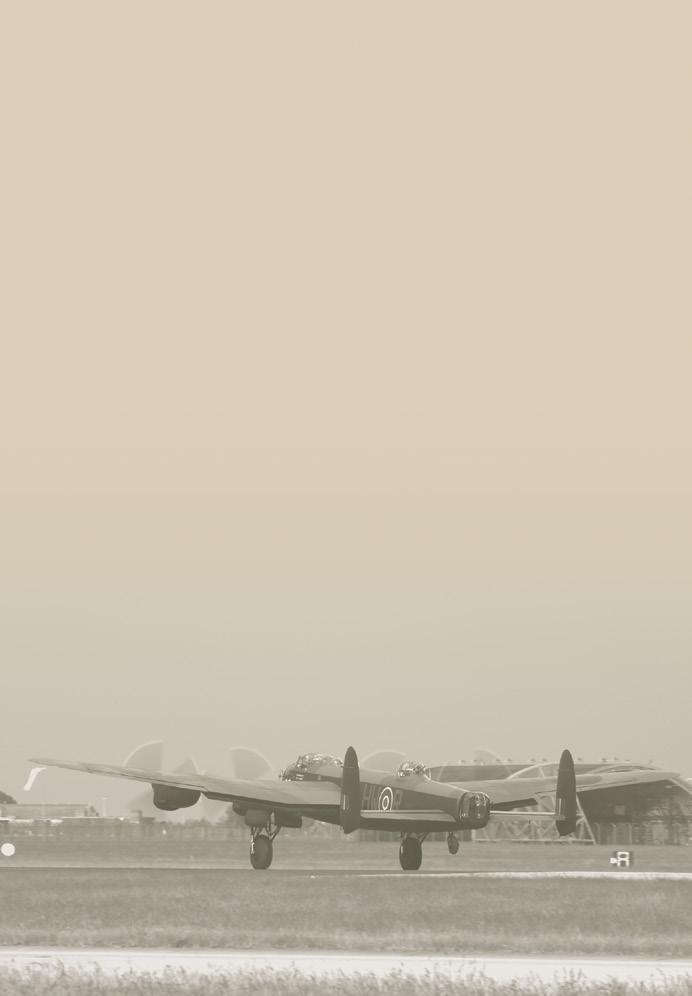
Contents West Lindsey | Contents 3 West Lindsey | Map 2 Fiskerton PAGES 18 & 19 Hemswell PAGES 20, 21 & 22 Hemswell Court PAGE 23 Ingham PAGES 24 & 25 RAF Ingham Heritage Centre PAGES 26 & 27 Scampton PAGES 28, 29 & 30 The Dambusters PAGE 31 Scampton Church and War Graves Heritage Centre PAGE 32 Abbreviations PAGE 4 Introduction PAGE 5 Bardney PAGES 6 & 7 Binbrook PAGES 8 & 9 Blyton PAGES 10 & 11 Caistor PAGE 12 William Farr Comprehensive School PAGE 13 Dunholme Lodge PAGES 14 & 15 Faldingworth PAGES 16 & 17 Acknowledgements: West Lindsey District Council gratefully acknowledges the following people and organisations for providing material for the booklet. Air Cdr Milligan CBE; Anne Law at the RAF Wickenby Memorial Collection; Colin-Mitchell Smith; Down To Earth Promotions; Geoff Burton at the RAF Ingham Heritage Centre; Lynn Bowering; Mark Thompson; Mike Chatterton; the N Franklin Collection – Newark Air Museum Archive; Richard Usher at the Blyton Park Driving Centre; Terry Senior Collection. Welton Church PAGE 33 South Carlton PAGES 34 & 35 Sturgate PAGES 36 & 37 Wickenby PAGES 38 & 39 RAF Wickenby Memorial Collection PAGE 40 Other Locations PAGE 41 Other Memorials PAGE 42 Surrounding Aviation Sites PAGE 43
map SOUTH CARLTON FALDINGWORTH WICKENBY BARDNEY WELTON BLYTON KEXBY STURGATE LAUGHTERTON SCAMPTON INGHAM HEMSWELL BLYBOROUGH COCKTHORNE DUNHOLME LODGE FISKERTON BINBROOK CUXWOLD CAISTOR 0 2 4 6 8 10 MILES NORTH Map reproduced by permission of Ordnance Survey on behalf of HMSO. Crown copyright and database right 2014. Ordnance Survey Licence number 100018701 BRANSBY EAST STOCKWITH LAUGHTON MARKET RASEN
Location
Abbreviations
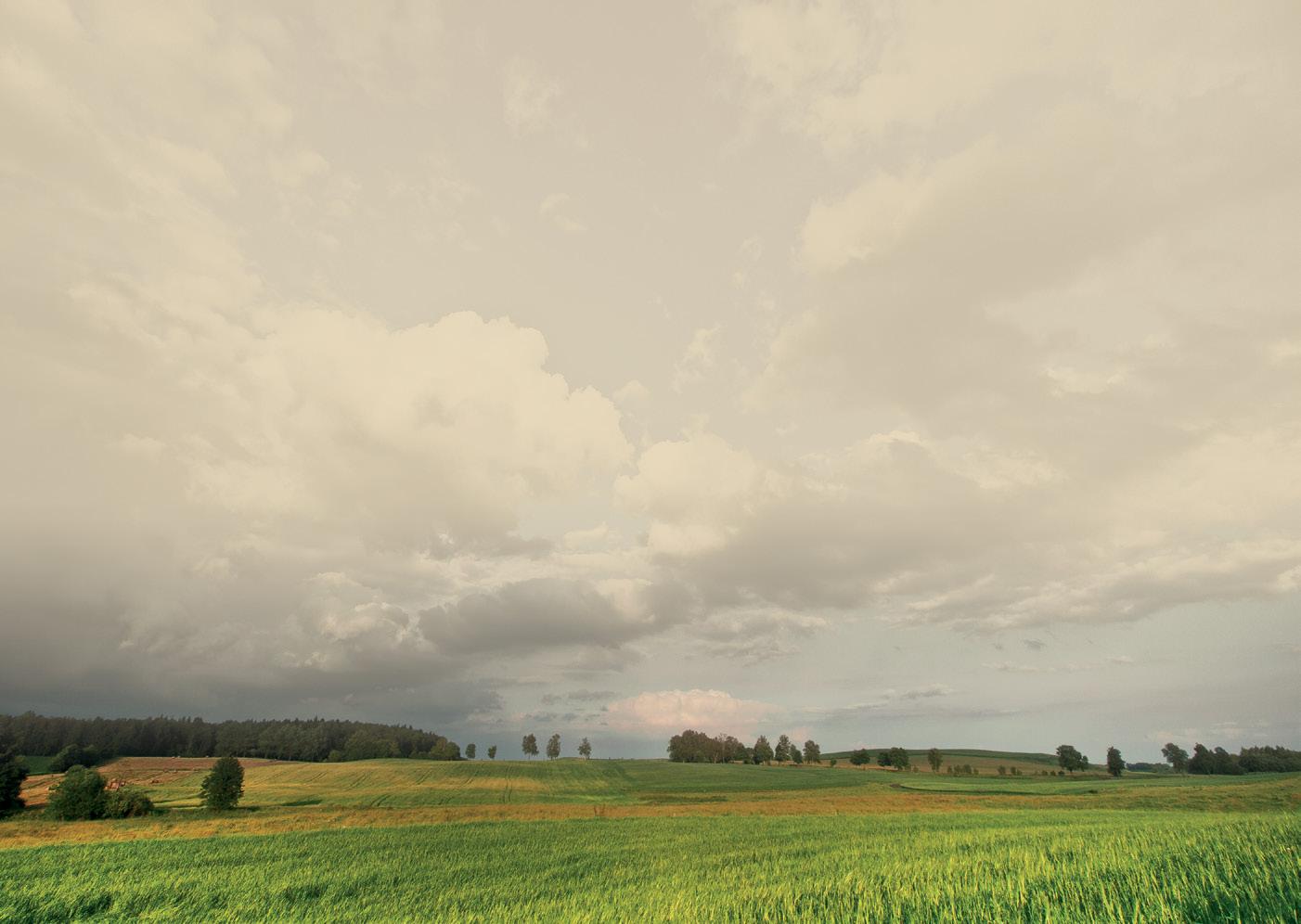
ABG ............ Air Base Group
ACHU ........ Aircrew Holding Unit
ACS ............ Air Base Squadron
AFC ............ Australian Flying Corps
AFU ............ Advanced Flying Unit
AHL ............ Aviation Heritage Lincolnshire
BAT Beam Approach Training
BDTF Bomber Defence Training Flight
BGF ............ Bomber Gunnery Flight
CFS ............. Central Flying School
FIDO .......... Fog Intense Dispersal Operation
Flt Lt Flight Lieutenant
FMT Flare Marking Force
F/O Flying Officer
GS Gliding School
HCU Heavy Conversion Unit
HD Home Defence
HLF Heritage Lottery Fund
HQ Headquarters
RLG ............ Relief Landing Ground
LCC ............. Lincolnshire County Council
LFS Lancaster Finishing School
LTF Lightning Training Flight
IRBM .......... Intermediate Range
Ballistic Missile
MC Maintenance Command
MU Maintenance Unit
NTS Night Training Squadron
PAF ............. Polish Air Force
PAFACT ..... Polish Air Force Association Charitable Trust
PHU Personnel Holding Unit
POW Prisoner of War
PRC Polish Resettlement Corp
PRU ............ Polish Resettlement Unit
R Reserve
RAAF Royal Australian Air Force
RAF ............. Royal Air Force
RFC ............. Royal Flying Corps
RFS ............. Refresher Flying School
RNAS ......... Royal Naval Air Service
ROC ........... Royal Observer Corps
RU ............... Resettlement Unit
SAC ............ Strategic Air Command
SAM Surface to Air Missile
Sgt Sergeant
SORT School of Recruit Training
Sqn Squadron
TDS Training Depot Station
TW Training Wing
US United States
USAF United States Air Force
USEC .......... United States Engineering Corps
VC ............... Victoria Cross
Wg Cdr ..... Wing Commander
WWI World War One
WWII World War Two
Airfields and memorials are an intrinsic part of Lincolnshire’s history. It is not the intention of West Lindsey District Council to celebrate aspects of war and death, but to commemorate the bravery of those involved, and to recognise the losses endured by both sides during two World Wars.
Military flying began before World War I and back then the people of the District saw very few aeroplanes. This changed with the threat of Zeppelin attacks and 33 Squadron moved into the area in late 1916 and established its Headquarters at Gainsborough, a flight station at Brattleby and landing fields at Blyborough, Cockthorne Farm and Cuxwold. More local airfields evolved to make use of the up-currents generated by the Lincoln edge escarpment.
From the mid-1930s the RAF expanded and new airfields were constructed to accommodate the new aircraft that were being brought into service. The District soon had three new airfields under construction, two at the former WW1 sites at Harpswell (now called Hemswell) and Scampton; and also at Binbrook. Both Hemswell and Scampton were operational at the outbreak
of WWII and Hampdens from Scampton took part in Bomber Command’s first offensive mission of the war.
During WWII a massive expansion programme saw airfields being built all over the District and as you drive around today you can see the remnants of many of these bases and their infrastructure. Some of these sites are featured in this booklet and they may be on private land; so please respect the privacy of those locations. The memorials featured are all publically accessible.
Post WWII three airfields in the District remained and they entered the Jet Age and Missile Era. Now, sadly no bases remain active in the District. We hope that you enjoy visiting the District and learning about its diverse aviation history.
West Lindsey | Introduction 5 West Lindsey | Abbreviations 4
Introduction
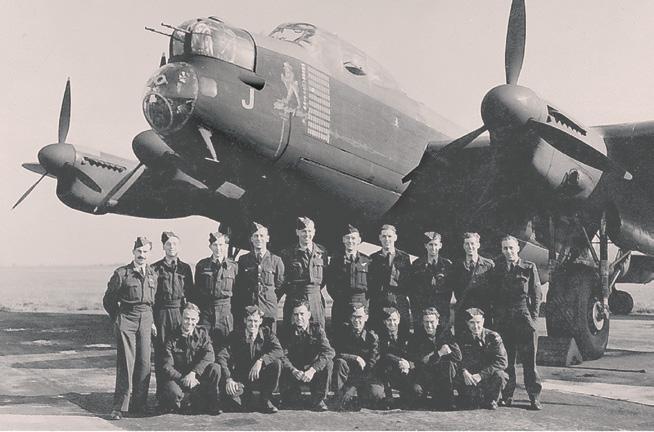
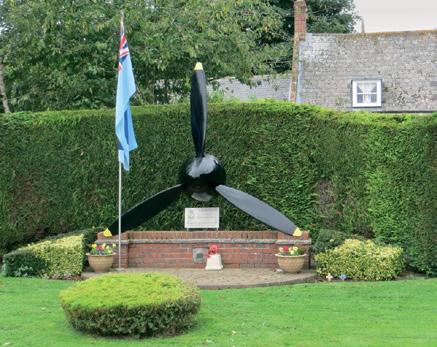
1. IX(B) Squadron personnel with Lancaster W4964, WS-J
2. RAF Bardney memorial on the village green
3. Bardney village sign
4. Bardney Heritage Centre
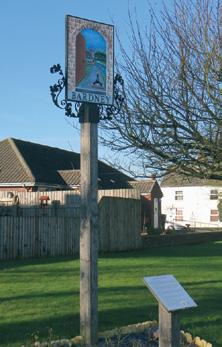
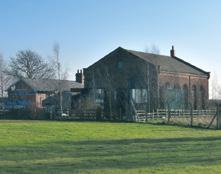
Bardney
RAF Bardney’s major wartime role was being the main base for IX(B) Squadron
LOCATION / GRID REF:
Sheet 121 SK135708; close to the B1202 Bardney to Wragby road
DATES OF OPERATION:
1943 to 1945 – bomber base
1945 to 1959 – storage & maintenance
1959 to 1963 – Thor missile base
SQUADRONS:
IX(B) Sqn; 227 Sqn; 189 Sqn; 106(SM) Sqn
RAF Bardney and the personnel of IX(B) Sqn are commemorated in an impressive memorial on the village green at the West Lindsey village of Bardney; map ref: Sheet 121 SK119693. The memorial features a Lancaster propeller and spinner, plus a stone from Kåfjord, Norway to mark the work of the Norwegian Resistance in the squadron’s attack on the Tirpitz battleship.
RAF Bardney’s major wartime role was being the main base for IX(B) Sqn, which along with 617 Sqn was one of the RAF’s main precision bombing squadrons. By a quirk of subsequent boundary changes the airfield is located in the East Lindsey District Council area. The base opened in April 1943 when IX(B) Sqn moved from RAF Waddington to Bardney. Early IX(B) Sqn operations out of Bardney coincided with the ‘Battle of the Ruhr’. IX(B) Sqn soon became established as a two Flt Main Force Squadron and during the ‘Battle for Berlin’ established a reputation for high accuracy bombing.
After WWII there was a period of use for storage and eventually Bardney returned to operations in a Cold War role as a Thor Missile Base, with 106(SM) Sqn being based there between 1959 and1963. The site was eventually used for gliding and by an aerial crop spraying company.
| Bardney 7
Lindsey | Bardney
West Lindsey
West
6 1 2 3 4
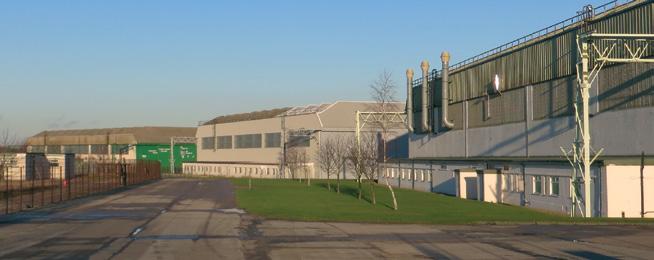
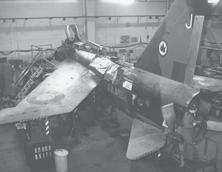
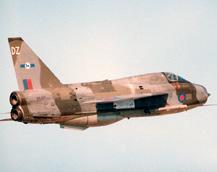
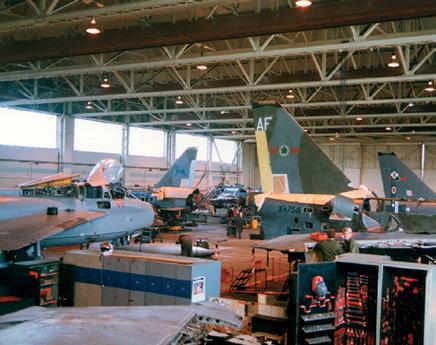
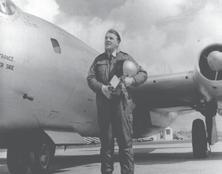
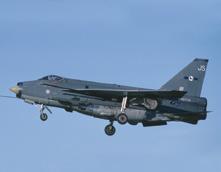
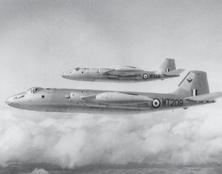
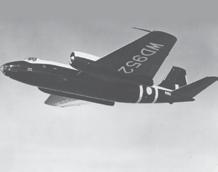
Binbrook
Following runway construction, the airfield re-opened in May 1943 and 460 Sqn, RAAF brought its Lancasters to Binbrook
LOCATION / GRID REF:
Sheet 113 SK195960; close to the Binbrook to Rothwell road
DATES OF OPERATION:
1940 to 1951 – bomber base, 1951 to 1959 – jet bomber base 1960 to 1989 – jet fighter base
SQUADRONS:
12 Sqn; 142 Sqn; 460 (RAAF); 1481 BGF; 101 Sqn; 617 Sqn; IX(B) Sqn; 50 Sqn; 64 Sqn; 85 Sqn; 5 Sqn; 11 Sqn; LTF
The first aircraft to arrive in June 1940 at the barely completed airfield within the No. 1 Group, Bomber Command were Battle light bombers of 12 and 142 Squadrons; survivors of the evacuation of France where they had been part of the Advanced Air Striking Force. In November 1940, both squadrons began to convert to Wellington bombers and operated the type until leaving in September 1942. 28 of the aircraft joined the 1,000 bomber raid on Cologne on 30 May 1942.
Following runway construction, the airfield re-opened in May 1943 and 460 Sqn, RAAF brought its Lancasters to Binbrook. The move from Breighton, Yorkshire was accomplished with the aid of Horsa gliders to transport the men and equipment. 1481 BGF was also resident on the airfield at this time, equipped with Wellington and Martinet aircraft to provide gunnery training for 1 Group air crew.
1481 BGF moved to Ingham in March 1944 and with the end of the war in Europe, 460 Sqn moved to East Kirkby to begin training for Tiger Force. Binbrook remained open as a bomber airfield with Lancasters, including those of 101 and 617 Sqns, until they were replaced by Avro Lincolns in mid-1947.
The Lincoln remained in service until 1951, when on 25 May Wg Cdr R P Beaumont delivered the RAF’s first jet bomber, the Canberra, to Binbrook. 101 Squadron was the first to receive the type and had completed conversion by the end of the year. 617 and the other Binbrook squadrons, 12, IX(B) and 50, began to receive Canberras in 1952. The Canberra remained at Binbrook until December 1959 when the station closed for a short period before being transferred to Fighter Command on 1 April 1960.
64 Squadron, equipped with Javelins, was the first fighter unit to operate from the airfield. During its stay, which lasted until 1965 the squadron’s aircraft were deployed to various trouble spots in the world. Javelins left the station in March 1965, and 5 Sqn re-formed on the airfield, becoming the first to be equipped with the Lightning F6, eventually joined by 11 Sqn in 1972. The LTF also operated with them until 1989, when the Lightning was retired and Binbrook closed as a military airfield.
The airfield which shared the name of its neighbouring village is now known as Brookenby. The RAF Binbrook Collection is being developed in the area, around the former Station Headquarters, which aims to preserve the heritage and stories from World War II through to the 1980s.
Lindsey | Binbrook 9 West Lindsey | Binbrook
West
8
today
1. How Binbrook’s former hangars look
2. Lightning undergoing servicing
P Beamont
Lightning landing at RAF Binbrook
Inside a Lightning Servicing Hangar
Canberras of IX(B) Squadron
Early Canberra bomber 1 2 3 4 5 6 7 8
3. A Lightning T5 takes off from RAF Binbrook 4. Wg Cdr R
5.
6.
7.
8.
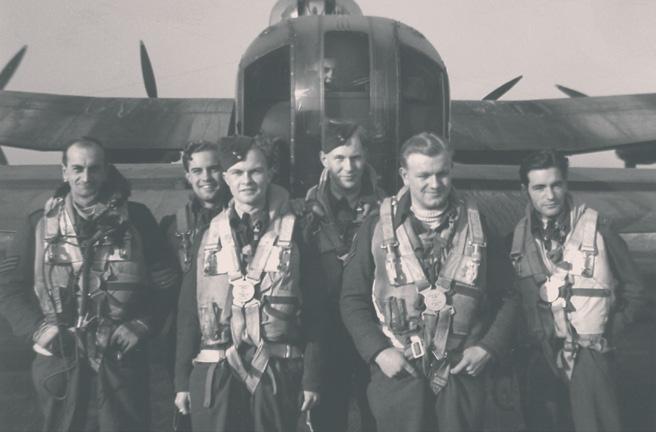
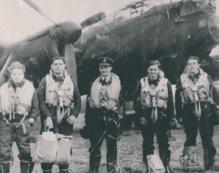
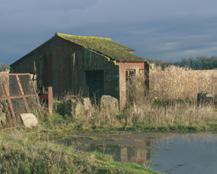
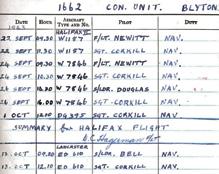
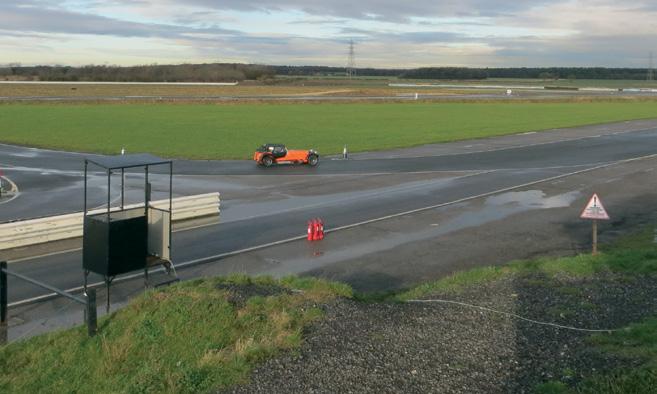
Blyton
RAF Blyton witnessed only a brief period of operational flying, being changed to the role of bomber training in February 1943
LOCATION / GRID REF:
Sheet 112 SK 874952; to the east of the A158 Blyton to Scotter road
DATES OF OPERATION:
1942 to 1946 – bomber training base
1950 to 1954 – relief landing ground
SQUADRONS:
18 OTU; 199 Sqn; 1662 HCU; 7 ACHU
Although built as a heavy bomber airfield within No. 1 Group Bomber Command and opened in April 1942, RAF Blyton witnessed only a brief period of operational flying, being changed to the role of bomber training in February 1943.
The first unit to occupy the airfield when it opened was B Flight of 18 (Polish) OTU, which operated Wellingtons in the training role in conjunction with the Polish squadrons which were then based at nearby Hemswell.
In November 1942 199 Squadron began to form on the airfield taking Wellingtons from 12 Squadron at Wickenby, as that unit was converting to Lancasters and commencing bombing and mining operations in December.
In February 1943 the role of the station changed with the arrival of 1662 HCU equipped with Halifax, Lancaster and a few Manchester aircraft. Manchesters were soon phased out, and in November 1943 the HCU became all Halifaxes, due to the shortage of Lancasters. It wasn’t until the end of 1944 that Lancasters returned to this HCU.
1662 HCU disbanded on 6 April 1945 and training ceased at Blyton. For a short time the station became the home of No. 7 ACHU, with several thousand aircrew passing through the unit on their release from the service, or for further training and a peace-time career with the RAF. The station was closed on 6 June 1946.
For a brief period in the early 50s Blyton was reactivated when it became a relief landing ground for the aircraft of 101 RFS based at Finningley. From September 1951 until May 1954 Wellingtons and Meteors operated from the airfield.
In 1954 the airfield at Blyton was finally closed and between 1961 and 1963 the 700 acre site was sold off by the Ministry of Defence. The land is now privately owned by the LNT Group, the manufacturers of Ginetta Cars.
Motorsport events and private track days are hosted at the site. As you drive into the location you are driving over former airfield taxiways and dispersal points. Some disused buildings / features can be seen around the site and local area, including lots of aircraft tie downs being used as makeshift field entrance barriers.
1. A crew training at 1662 HCU, RAF Blyton
2. A crew training at 1662 HCU, RAF Blyton
3. A wartime building alongside the current airfield entrance
4. Log Book entries for 1662 HCU, RAF Blyton
5. Blyton Park today
|
11
West Lindsey
Blyton
|
West Lindsey
Blyton
10
1 2 3 4 5
Caistor
A Flight of 264 Sqn, equipped with Defiants in the night fighter role operated at the site
LOCATION / GRID REF:
Sheet 112 SK 084023; to the west of the A46 road out of Caistor
DATES OF OPERATION:
1940 to 1944 – fighter & training base 1958 to 1963 – Thor missile base
SQUADRONS:
264 Sqn; 85 Sqn; 15 AFU; 346 Co USEC; 269 Sqn
The all grass airfield at Caistor opened in September 1940 as a satellite to Kirton in Lindsey, a fighter airfield within 12 Group Fighter Command. A Flight of 264 Sqn, equipped with Defiants in the night fighter role, operated at the site for a few weeks before being replaced by A Flight of 85 Sqn, who spent some time undergoing further training from Caistor.
From May until December 1942 the airfield was used by 15 (Pilot) AFU, at that time based at Kirmington. Control of the airfield was then passed to RAF Manby who in turn loaned Caistor to Cranwell for night flying training. A flight of Harvards operated from the airfield from March to November 1944, after which time flying ceased.
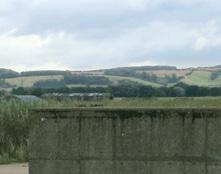
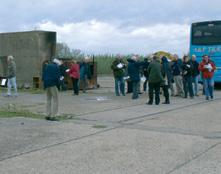
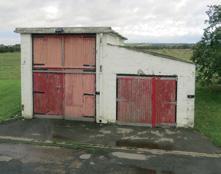
For the last few months of the WWII several ground units occupied the airfield including personnel of the 346 Company USEC. At the end of the war the station was transferred to the Ministry of Agriculture for allocation to local farmers.
Part of the airfield site was returned to Air Ministry control in 1958 for the construction of a site for Thor IRBMs. 269 Sqn reformed with 3 missiles as part of the Hemswell Wing and occupied the site until 1963 when the missiles were withdrawn. The airfield site was finally sold back for agricultural use in 1964. Some significant parts of the Thor missile launch areas remain intact at Caistor, but these are on private land.
WILLIAM FARR COMPREHENSIVE SCHOOL
ADDRESS:
William Farr (Church of England)
Comprehensive School, Lincoln Road, Welton, Lincoln LN2 3JB
Telephone No: 01673 866900
Email: wfarr@williamfarr.lincs.sch.uk
Website: www.williamfarr.lincs.sch.uk
William Farr Comprehensive School is a Church of England school for 11 - 18 year olds, located in the village of Welton, near Lincoln. It was opened in 1952 on one of the former domestic sites of RAF Dunholme Lodge, which had been bought for £600 in 1946 by William Farr, the vicar of Welton. The school was named after him when he died in 1955.
The school is proud of its aviation heritage and the school library has a range of material relating to RAF Dunholme Lodge, including photographs of Polish Air Force and Polish Resettlement Corps. Also in the school is the Lawres Chapel, which was built as “a place of quiet reflection, contemplation and prayer” and was opened in 2004 by Rt. Rev. John Saxby, Bishop of Lincoln. It is home to the Helen Alwyn memorial window and the RAF Book of Remembrance, which honours those who served and died during World War II and were stationed at RAF Dunholme Lodge. A daily act of remembrance sees members of Year 7 turning a page in the RAF Book of Remembrance. The chapel is available to all members of the school of any faith or none and also accommodates reunion visits from the Squadron Associations with connections to RAF Dunholme Lodge.
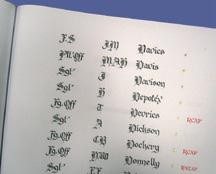
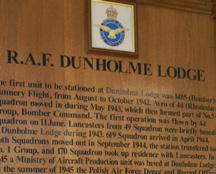
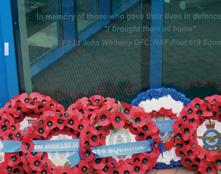
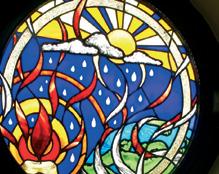
In the nearby village of Dunholme, St Chad’s church (Sheet 121 SK025794) houses a memorial plaque, which is dedicated to 44 (Rhodesia) Sqn.
West Lindsey | Caistor
12
View across the remains of the Thor missile site at Caistor 2. Private tour of the Thor missile site at Caistor 3. Remains of the Fire Station at Caistor 1 2 3 LOCATION / GRID REF:
121 SK 013793;
on the main
into Welton village
the A46 road
1.
Sheet
Located
road
from
Lindsey | Welton 13
West
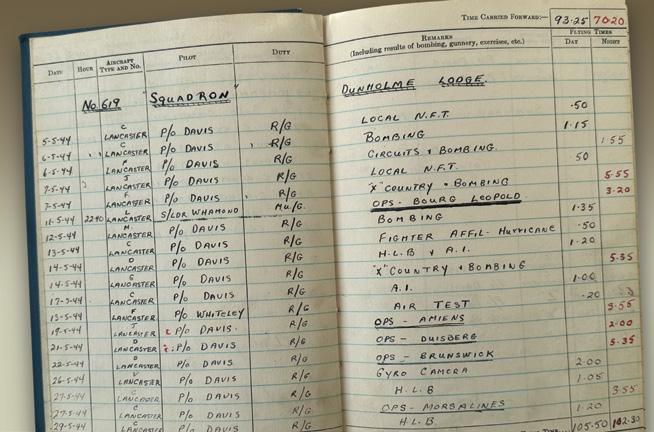
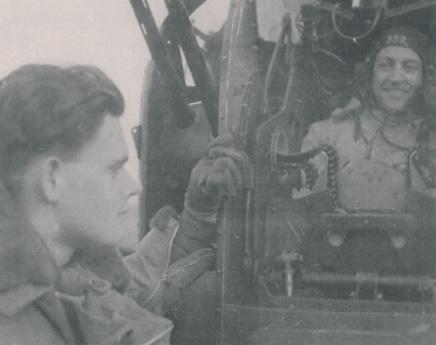
1. Log Book entries for a 619 Squadron rear gunner at RAF Dunholme Lodge
2. P/O J Chatterton and his rear gunner, 44 (Rhodesia) Squadron
3. 44 (Rhodesia) Squadron crew ready for an Op
4. 44 (Rhodesia) Squadron Lancaster at RAF Dunholme Lodge
5. Postagram awarding the DFC to P/O J Chatterton of 44 (Rhodesia) Squadron
Dunholme Lodge
The main runway was extended in February 1944, allowing aircraft with an all-up weight of 65,000lbs to take off in a westerly direction
LOCATION / GRID REF:
Sheet 121 SK 002783; parts still visible from various points around the village of Welton just off the A46 road
DATES OF OPERATION:
1943 to 1947 – bomber base & glider modification
1958 to 1963 – Bloodhound missile base
SQUADRONS:
44 Sqn; 49 Sqn; 619 Sqn; 170 Sqn; 141 Sqn
Dunholme Lodge airfield was built as a satellite to Scampton, and the first unit based there was 44 Sqn, which arrived from Waddington in May 1943 whilst new runways were being constructed there. 49 Sqn also arrived in September 1943 and remained for a month while runway repairs were carried out at its home base at Fiskerton.
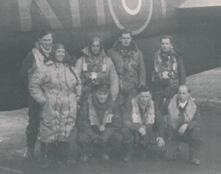
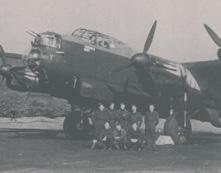
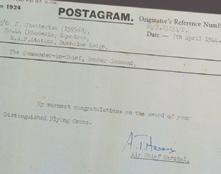
The main runway at Dunholme Lodge was extended in February 1944, allowing aircraft with an all-up weight of 65,000lbs to take off in a westerly direction, previously impossible because of the adverse gradient. This was completed in time for the arrival of 619 Sqn from Coningsby on 17 April. The squadron operated its Lancasters from the airfield until September 1944 when it moved to Strubby. 44 Sqn moved to Spilsby at the same time. 170 Sqn moved in from Kelstern in October but because of problems experienced with flight patterns at nearby Scampton it was decided to cease operations in November 1944.
Dunholme was then earmarked for non-operational units, and the first of these to arrive was the Ministry of Aircraft Production Glider Modification Detachment. The unit was allocated two hangars and workshops and carried out modifications to Hamilcar gliders. One such modification tested at Dunholme was the Hamilcar Mk 10, a powered version of the glider. The Glider Unit left the airfield at the end of June 1945.
With the end of hostilities all flying ceased at Dunholme and, for a short period, the site was used by the Polish Resettlement Corps before being closed down in late 1947. In the late 1940s several motor racing meetings were held on the former runway.
In 1958 the Air Ministry reclaimed part of the airfield for use as a Bloodhound SAM site, to act as a defence for the nearby V Bomber bases and Thor IRBM sites. 141 Sqn was formed in April 1959 to operate the missiles at Dunholme which remained in use until early 1964, when the squadron was disbanded and the airfield closed. Over the next couple of years the base was sold off by the Ministry and some returned to farming use.
Buildings and parts of the former airfield are still in existence, but most are on private land. The base’s history is commemorated at the William Farr (Church of England) Comprehensive School in Welton.
West Lindsey | Dunholme Lodge 15 West Lindsey | Dunholme Lodge
14
1 2 4 5 3 1
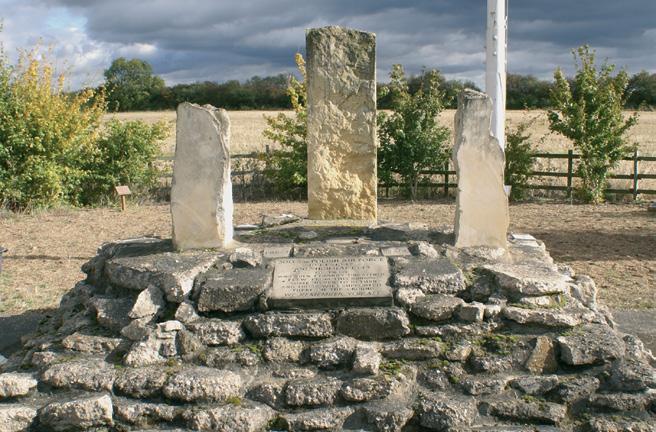
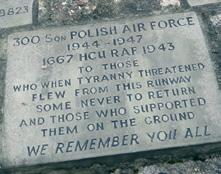
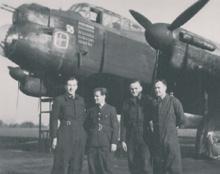
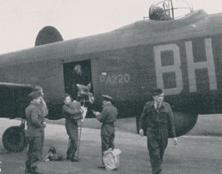
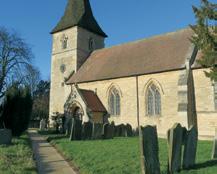
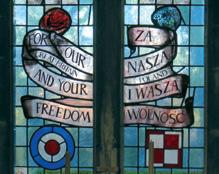

Faldingworth
Faldingworth became an operational airfield, with the HCU moving to Sandtoft and 300 (Polish) Sqn, became the only Polish unit to operate the Lancaster
LOCATION / GRID REF:
Sheet 121 SK 035855; located close to the North side of the Faldingworth village to Spridlington village road. Faldingworth lies on the A46 road
DATES OF OPERATION:
1943 to 1947– bomber & training base 1949 to 1972 – munitions storage
SQUADRONS:
1667 HCU, 300 (Polish) Sqn; 93 MU; 92 MU
Real aircraft replaced the dummies of the Toft Grange K Site Decoy Airfield when the site became an airfield within 1 Group Bomber Command in July 1943. The mixed strength of Lancasters and Halifaxes of 1667 HCU arrived from RAF Lindholme on 8 August.
With the decision to concentrate all Lancaster training in No 1 Group to a single unit, the Lancaster flight of 1667 HCU became the Lancaster Finishing School. The Conversion Unit became all Halifaxes with strength of 32 aircraft.
On 1 March 1944 Faldingworth became an operational airfield with the HCU moving to Sandtoft and 300 (Polish) Sqn, the only Polish unit to operate the Lancaster, commencing operations from Faldingworth. By 1945 there were over 1000 Polish personnel on the base, these included some 200 Polish WAAFs. 300 Sqn played its part in the bomber offensive and at the end of the war participated in ‘Operation Dodge’, the repatriation of prisoners of war, and ‘Operation Manna’, the dropping of food supplies to the Dutch.
The Squadron ceased operations in Germany on 2nd January 1947, and disbanded totally on 6 January 1947. The station was then placed on Care and Maintenance and came under the control of RAF Hemswell.
In April 1949 Faldingworth became a sub-site for 93 MU within 42 Group Maintenance Command, which controlled the airfield until October 1957 when it was transferred to 92 MU, tasked with supplying specialist munitions to other RAF Units. In November 1972 92 MU was disbanded and Faldingworth closed down.
Subsequently the munitions storage area was taken over and used for arms storage and manufacture; and this part of the site still operates today. The wartime role is commemorated by an impressive memorial on another part of the airfield, which features concrete blocks from the old runway and other airfield locations. This memorial is part of the Polish Bomber Squadron Trail and can only be visited by prior arrangement. If you wish to make a visit please contact the RAF Ingham Heritage Centre, which is featured later in this booklet. This must be done in advance of any proposed visit.
1. RAF Faldingworth airfield memorial
2. Inscription on the RAF Faldingworth airfield memorial
3. The Path of Friendship leading to All Saints Church
4. 300 Squadron Memorial Stained Glass Window
5. Polish aircrew at RAF Faldingworth
6. View of the Faldingworth taxiway today
7. Polish aircrew at RAF Faldingworth
In Faldingworth village is All Saints Church (Sheet 121 SK 066847) and this is the home to a number of memorials. You reach the church by walking along the Path of Friendship and as you enter you see the Memorial Porch Outer Gates, which were dedicated in October 2005. On the wall facing you is the beautiful 300 Squadron Memorial Stained Glass Window, which was dedicated in September 1999 and forms the carefully designed backdrop to many commemorative items, scrapbooks and displays.
Lindsey | Faldingworth 17 West Lindsey | Faldingworth
West
16
1 2 3 4 6 5 7
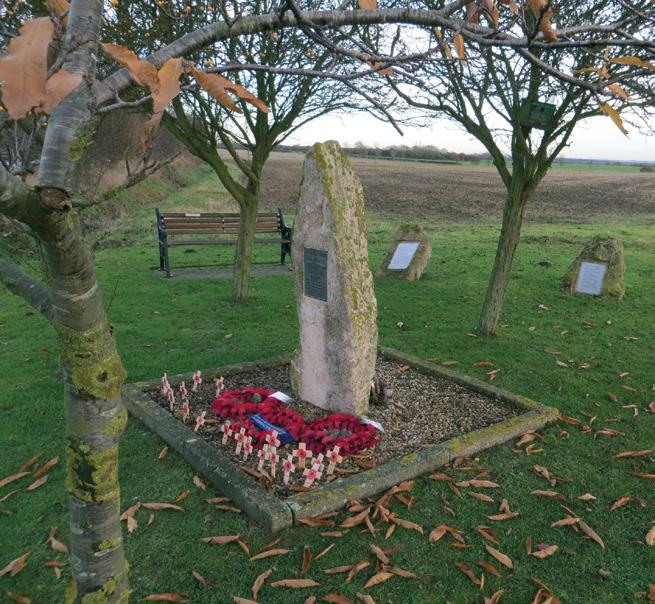
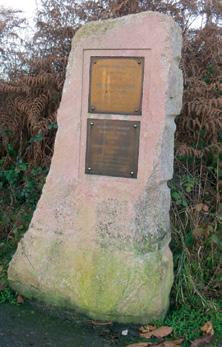
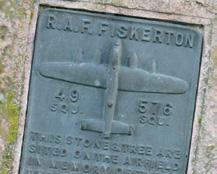
2.
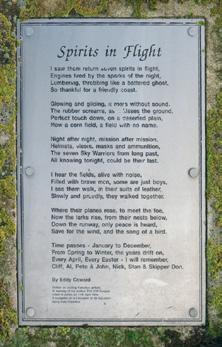
1.
Fiskerton
RAF Fiskerton was a bomber airfield within 1 Group, Bomber Command, at the beginning of 1943
LOCATION / GRID REF:
Sheet 121 SK 045730; the Reepham to Fiskerton road crosses significant parts of the former runway
DATES OF OPERATION:
1942 to 1946 – bomber base
1961 to 1992 – ROC Group HQ
SQUADRONS:
49 Sqn; 576 Sqn; 150 Sqn; 625 Sqn; 15 Group ROC
49 Sqn arrived at RAF Fiskerton, a bomber airfield within 1 Group, Bomber Command, at the beginning of 1943, the airfield having been constructed the previous year. The squadron remained at Fiskerton with its Lancasters until October 1944 when it was transferred to Fulbeck. At the end of that month 576 Sqn brought its Lancasters from Elsham Wolds, and at the same time 150 Sqn was reformed as a Lancaster unit on the airfield. Once operational, 150 Sqn moved on to Hemswell.
Fiskerton became one of several Lincolnshire airfields to be equipped with FIDO equipment. C Flight of 625 Sqn, Kelstern, moved to Fiskerton on 5 April 1945, with C Flight of 576 Sqn, and on 19 September 1945 the Sqn was disbanded.
With an end to flying the airfield was handed over to 40 Group Maintenance Command who used the airfield for storage purposes for a short while.
A famous story from the local area in WWII concerns a 207 Sqn Manchester, which made a miraculous crash-landing in a Fiskerton lake, narrowly missing a fisherman on the water. Later one of the survivors jumped out of an ambulance and briefly ran naked through Lincoln.
The majority of the airfield’s 630 acres were disposed of during the mid-1960s but in one corner of the former site stands the control bunker headquarters of 15 Group, ROC. This became operationally redundant as the Corps disbanded in 1992 and can still be seen on private land as you enter the village of Fiskerton.
A series of memorials can be found where the Reepham to Fiskerton road crosses some significant parts of the former runways / dispersals; a small off road parking area allows visits to be made to these memorials.
In the Lady Chapel of St Clement of Rome Church in Fiskerton village (Sheet 121 SK 047720) there is a memorial plaque commemorating the personnel of RAF Fiskerton from 1943 to 1945; it also houses a Roll of Honour for 49 Squadron personnel. This location is best visited during West Lindsey’s Open Churches Festival held annually in May.
West Lindsey | Fiskerton 19 West Lindsey | Fiskerton
18
RAF Fiskerton memorials
Personnel memorial plaques at Fiskerton
Memorial plaque to 49 & 576 Squadrons
‘Spirits in Flight’ poem 1 4 2 3
3.
4.
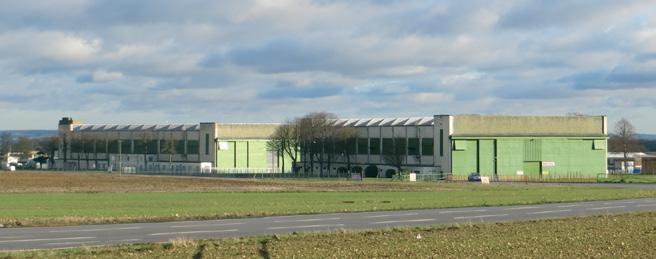
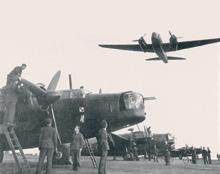
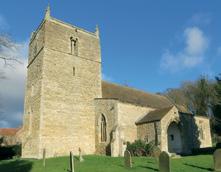
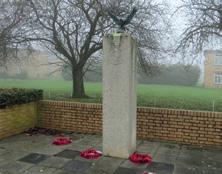
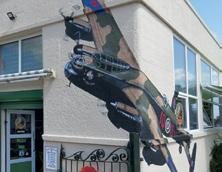
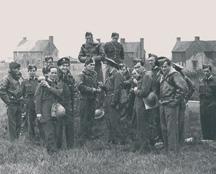
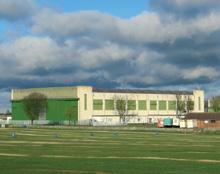
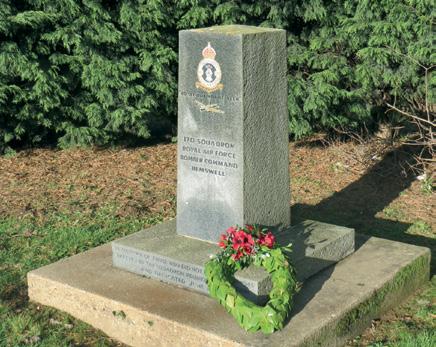
1. View over the former RAF Hemswell airfield
2. Wellington bomber overflies
5.
Hemswell
RAF Hemswell opened in 1936; this expansion period airfield encompassed the whole of the area of the WWI Harpswell aerodrome. The new station had an establishment for two medium bomber squadrons.
LOCATION / GRID REF:
Sheet 112 SK 944908; close to the A631 Gainsborough to Market Rasen road
DATES OF OPERATION:
1916 to 1919 – WWI night landing ground and training base
1936 to 1952 – bomber base
1952 to 1957 – jet bomber base
1957 to 1963 – Thor missile base
1957 to 1963 – training & gliding
SQUADRONS:
33(HD) Sqn; 199 NTS; 200 NTS; 144 Sqn; 61 Sqn; 300 (Polish) Sqn; 301 (Polish) Sqn; 305 (Polish) Sqn; 1LFS; 150 Sqn; 170 Sqn; 109 Sqn; 139 Sqn; 83 Sqn; 100 Sqn; 50 Sqn; 61 Sqn; 12 Sqn; 97 Sqn; 109 Sqn; 76 Sqn; 542 Sqn; 2 SORT; 643 GS
This base started out as Harpswell, a WWI night Landing ground for 33(HD) Sqn. After expansion and the addition of hangars and other permanent features it became home to 199 and 200 NTS units, and eventually closed in 1919.
RAF Hemswell opened on 31 December 1936; this expansion period airfield encompassed the whole of the area of the WWI Harpswell aerodrome. The new station had an establishment for two medium bomber squadrons. The first to arrive was 144 Sqn in February 1937, followed almost immediately by 61 Sqn which formed on the airfield on 8 March, both units equipping with Anson and Audax aircraft.
In the autumn of that year Blenheims began to arrive to replace the ageing Audax, both squadrons being re-equipped by December. The Blenheims were replaced by Hampdens early in 1939; both squadrons receiving the type before war was declared in September, and they took part in some of the early raids of the war.
Hemswell itself saw action – it was the first airfield in Lincolnshire to receive the attention of the Luftwaffe. On 29 August 1940, several bombs were dropped on the airfield, one (which failed to explode) left a large crater on the Parade Square when it was detonated the following day.
6.
7.
8.
144 and 61 Sqns left Hemswell in July 1941 to be replaced by 300 and 301 (Polish) Sqns who brought their Wellingtons from Swinderby. On 18 May 1942 300 Sqn moved to Ingham, to be replaced on the airfield by 305 (Polish) Sqn. Due to reorganisation of the Polish Forces 300 Sqn returned to Hemswell on 31 January 1943, and with 301 Sqn being withdrawn from operations, its personnel and aircraft were used to bring 300 Sqn up to strength. Later that year both squadrons were moved to Ingham to allow runways to be constructed at Hemswell.
When runway construction was completed in January 1944, No 1 LFS moved to the airfield from Lindholme. The LFS was formed to give some Lancaster experience to aircrew from nonLancaster conversion units prior to joining operational squadrons. However, as the Lancaster
West Lindsey | Hemswell 21
Lindsey | Hemswell
West
20
RAF Hemswell
Airmen at RAF Hemswell
A wartime hangar at Hemswell
3.
4.
Harpswell church
RAF Hemswell memorial located close to the Antiques Centre
170 Squadron memorial at Hemswell Cliff
Café mural 1 2 3 4 5 6 7 8
6
became more plentiful in late 1944, it was possible to equip training units with the type and so the need for the LFS was gone and accordingly the unit was disbanded.
Hemswell saw a return to operational flying on 22 November 1944 with the arrival of 150 Sqn from Fiskerton and then 170 Sqn from Dunholme Lodge. These two Lancaster units operated from the airfield until the end of the war, both Squadrons disbanding in November 1945.
Like the other two expansion period airfields in West Lindsey, Hemswell was to be retained for the peace-time air force and the Lancasters were replaced by Mosquitos of 109 Sqn and 139 Sqn. These two units remained for about a year. It was at this time that four engine bombers returned to Hemswell; these were Lincolns from 83 Sqn and 100 Sqn, which arrived in late 1946 and were joined by 97 Sqn.
50 and 61 Sqns operated from Hemswell between July and December 1947 while Waddington’s runways were being repaired, and due to severe winter weather, 12 Sqn brought its Lincolns from Binbrook for 3 months in 1948. The Mosquitos of 109 and 139 Sqns returned from Coningsby in March 1950 and 100 Sqn moved to Waddington. Hemswell’s four Squadrons, 83 and 97 with Lincolns and 109 and 139 with Mosquitos formed the No 1 Group FMF.
During the latter half of 1952, both 109 and 139 Sqns began to convert to Canberras. 83 and 97 Sqns relinquished their flare marking role and began to train navigators for the planned V Force.
In April 1957 Hemswell became the home of the Nuclear Weapons Task Force, comprising Canberras of 76 and 542 Squadrons modified for high altitude cloud sampling. Both Squadrons took part in ‘Operation Grapple’, the Christmas Island H Bomb Trials. Hemswell was selected as a Thor missile site and work commenced in 1957 on the construction of the 3 missile launching pads. 97 Sqn reformed on 1 October 1958 to operate the missiles and the Hemswell Missile Wing controlled the Thor sites at Bardney, Caistor, Coleby Grange and Ludford Magna. Many of the missiles supplied by the Americans were flown directly into Hemswell from the United States but when Hemswell closed for flying in late 1959 further deliveries were made through Scampton. Likewise when the missiles were withdrawn in 1963 they were returned to America via a similar route.
Hemswell was closed in November 1963. However, with an increase in recruitment, Hemswell reopened in 1965 as No 2 Wing of 7 SORT that was located at RAF Swinderby. Intakes continued until March 1967 and the last entry passed out from Hemswell on 12 May that year. Hemswell saw very little more air force activity, apart from No 643 GS that operated on the airfield for a short time, as did the civilian Lincoln Aero Club.
During 1972 the accommodation was used to house displaced Ugandan Asians. The pre-war C type hangars are now used as grain stores and in 1985 the airfield was sold off and is now used for a variety of industry and commerce. The formed H blocks surrounding the main parade ground (now a car park) have been converted and now form the largest antique centre in Europe (Hemwell Antiques Centres) attracting visitors from all over the world. Almost 300 dealers operate from the site which is open 7 days a week.
There are two memorials at RAF Hemswell. A memorial stone in the car park area of Antique Centre close to the Canberra Antique Centre (Sheet 112 SK 949 900) commemorates Royal Air Force Bomber Command Hemswell 1937 – 1967. While the second, that commemorates 170 Squadron personnel, is located on the northern side of the A631 road opposite a convenience store, (Sheet 112 SK 948 897).
HEMSWELL COURT
ADDRESS: Hemswell Court Limited, Lancaster Green, Hemswell Cliff, Lincolnshire DN21 5TQB
Telephone No: 01427 668508
Email: functions@hemswellcourt.com
Website: www.hemswellcourt.com
Hemswell Court is described by many as one of Lincolnshire’s hidden treasures. The wedding, dinner dance and conference facility is located in the Officers’ Mess buildings at the former Hemswell RAF base.
The owners of Hemswell Court were active in establishing the AHL aviation partnership, and the site’s aviation connections are highlighted by the inclusion of a detailed airfield history section on the venue’s website.
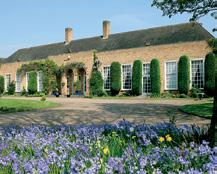
Elsewhere on the Hemswell site is the Hemswell Antiques Centre, which brings together Europe’s largest selection of dealers who can offer you the widest possible range of antiques, collectables and antique furniture. Within 3 separate buildings you will find around 300 display areas.
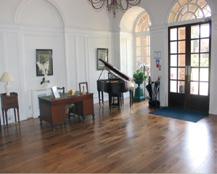
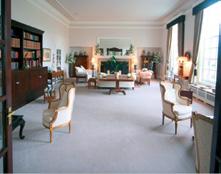
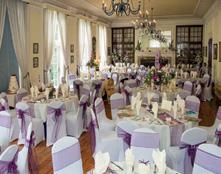
In St Chad’s village church in nearby Harpswell (Sheet 112 SK 936899) a roll of honour in memory of personnel from RAF Hemswell is mounted in the church. Accompanying the roll of honour is a commemorative flower stand.
Lindsey | Hemswell 23 West Lindsey | Hemswell 22
West
LOCATION / GRID REF: Sheet 112 SK 946897; Located north of Lincoln on the A631 close to the junction with the A46
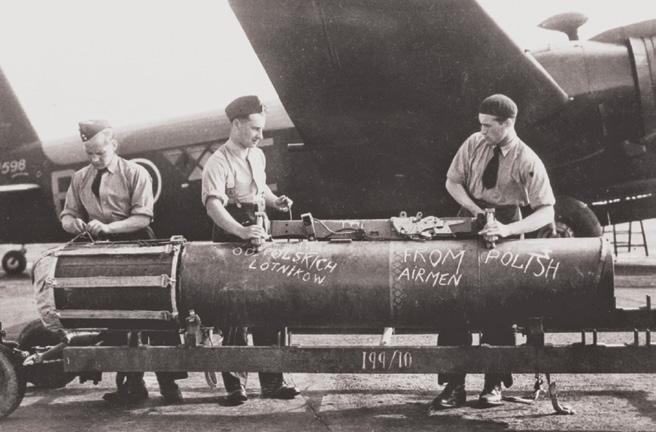
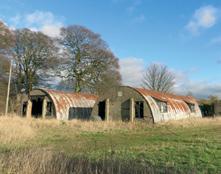
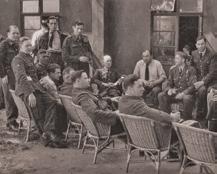
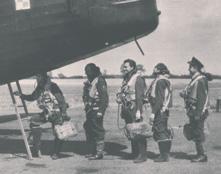
Ingham
In 1944 the Air Ministry, belatedly, announced the re-naming of RAF Ingham to RAF Cammeringham
LOCATION / GRID REF:
Sheet 121 SK 960840; accessed off the B1398 Middle Street (Ingham to Fillingham road)
DATES OF OPERATION:
1940 to 1946 – bomber & training base
SQUADRONS:
300 (Masovian) Polish Sqn; 199 Sqn; 305 (Wielpolska) Polish Sqn; 1687 BDTF; 1481 BGF; No 4 PHU; No 1 PRU
Construction of the airfield started in 1940 and was used as a RLG. In May 42, the airfield officially opened as RAF Ingham, with the arrival of No. 300 (Masovian) Polish Sqn, flying Wellingtons. They stayed until January 1943, when they returned to RAF Hemswell.
In February 1943, No. 199 Sqn arrived from RAF Blyton, but theirs was a short stay, leaving in June 1943. The very next week, saw the arrival No. 300 Sqn and their fellow countrymen of No 305 (Wielpolska) Polish Sqn, which was due to concrete runways being constructed at RAF Hemswell. No. 305 Sqn only stayed for the summer, and in September they became nonoperational, in preparation for their transfer to RAF Swanton Morley.
Towards the end of 1943, the Polish Air Force Command persuaded Bomber Command to equip a Polish squadron with the Avro Lancaster; with the obvious choice being No. 300 Sqn. However, with Ingham’s grass runways in poor condition, the airfield was considered unsuitable for the heavier bombers. So, in March 1944, 300 Sqn finally left RAF Ingham for the final time and relocated to RAF Faldingworth, with its concrete runways.
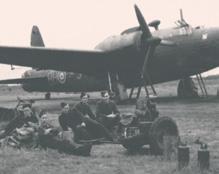
1. RAF Ingham - 300 Sqn Arming a Sea Mine - Summer 1943
2. Disused cinema building
3. Sgt Roman Konatkiewicz (305 Sqn) nearest camera - Sgts Mess, RAF Ingham, Summer 1943
4. 305 Squadron Wellington
5. Ground crew in front of a Wellington bomber
6. Refuelling a Wellington bomber at RAF Ingham
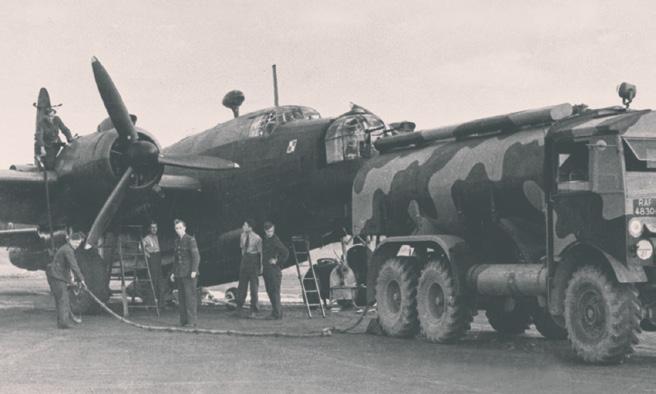
Following their departure, the airfield was designated non-operational and became home to variety of training and lodger units. After much confusion and instances of essential spares being delivered to the villages of Ingham in Norfolk and Ingham in Suffolk, on 24 November 1944 the Air Ministry, announced the re-naming of RAF Ingham to RAF Cammeringham.
At the end of hostilities, many Polish servicemen and women chose not to return to the now communist governed Poland and decided to remain in the UK, making it their new home, under the Polish Resettlement Act of 1947. Formed in 1946 the Polish Resettlement Corps (PRC) provided Polish personnel with a trade, and language lessons, for integration into British society. Polish Resettlement Units (PRU) were built to accommodate these personnel and their families.
RAF Cammeringham had a PRU, which was built on a former RAF accommodation site, at the southern edge of Ingham Village. Nissen Huts were internally designed to create basic yet austere family dwellings. The site was occupied by Polish and then British families, into the early 1950s.
In 1946, the Air Ministry returned the airfield land to the owners. Little of the airfield still remains, and it is all on private property, so please do not access without permission.
In All Saints Church in Ingham village (Sheet 121 SK 950836) there are memorial plaques commemorating the personnel and Squadrons / units of RAF Ingham from 1940 to 1946.
This location is best visited during the Open Churches Festival held annually, during May.
| Ingham 25
West Lindsey
| Ingham
West Lindsey
24
1 2 3 4 6 5
RAF INGHAM HERITAGE CENTRE
LOCATION / GRID REF:
Sheet 121 SK 960840; accessed off the B1398 Middle Street (Ingham to Fillingham road)
ADDRESS:
RAF Ingham Heritage Centre, Middle Street, Fillingham, Gainsborough, Lincs DN21 5BU
Telephone No: 01522 731861
Email: enquiries@rafingham.co.uk
Website: www.rafingham.co.uk
RAF Ingham Heritage Group was formed in 2010, and became a Registered Charity in 2011.
Over the last 14 years they have embraced a herculean challenge of turning an old farm storage building (formerly the wartime Airmen’s Mess), into wonderful and fitting location, to tell an almost forgotten story.
In 2024, a team of volunteers at RAF Ingham have created a globally unique Heritage Centre, dedicated to remembering and celebrating (through their own personal stories) the remarkable lives and memories of the men and women (both ground and air crews) of the Polish Air Force Bomber Squadrons, who lived, worked and flew alongside the RAF during the Second World War. It also tells the humanitarian story of their struggles to settle and integrate into ‘post-war’ Britain, whilst retaining their customs, culture and Polish heritage.
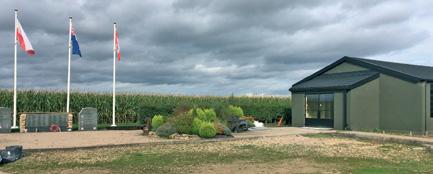
The Centre also remembers and celebrates the remarkable lives and memories of the men and women (both ground and air crew) who served at RAF Ingham/Cammeringham.
The Main Exhibition Centre comprises of:- two wings, covering over 4602m of exhibition space; an atmospheric Polish Families Nissen Hut; a Mini-Cinema, Shop and Toilets. Around the Site there is also a Memorial Garden, the Remembrance Garden, Volunteer Workshop, Nissen Hut Vegetable Garden, and not forgetting their ‘Airmen’s Rest’ Cafe and Picnic Area.
The site also benefits from free parking and same-level access in almost all areas. Guided tours and group bookings are available by prior arrangement (dependent on staff availability). The entire exhibition is bi-lingual (Polish and English).
For more visitor information, including opening times, please visit their website.
RAF Ingham Heritage Centre was awarded The King’s Award for Voluntary Service in 2023, the highest award a local voluntary group can receive in the UK, and is equivalent to an MBE.

The RAF Ingham Heritage Centre is also a focal point of the Polish Bomber Squadrons Trail, which covers five locations across Lincolnshire and one in neighbouring Nottinghamshire. The Trail tells the engaging story of the men and women of the wartime Polish Bomber Squadrons who served at locations across the county and who eventually made Lincolnshire their home. Further information can be found on the RAF Ingham Heritage Centre website.
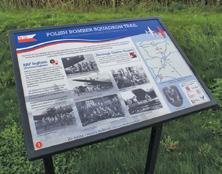
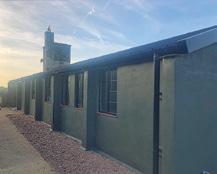
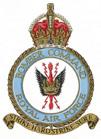

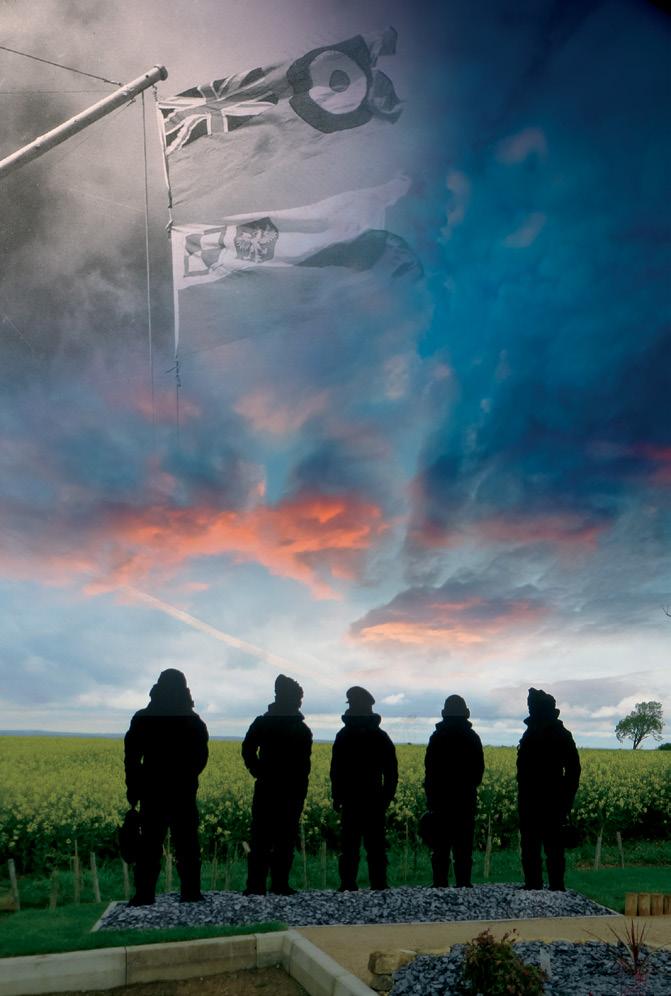
West Lindsey | Ingham 26
Lindsey | Ingham 27
West
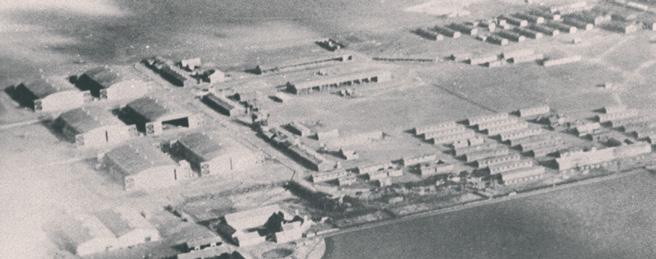
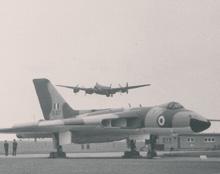
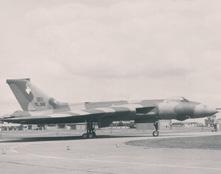
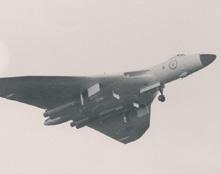
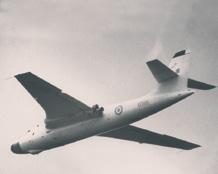
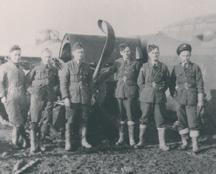
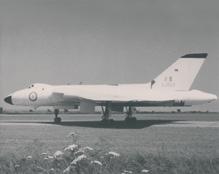
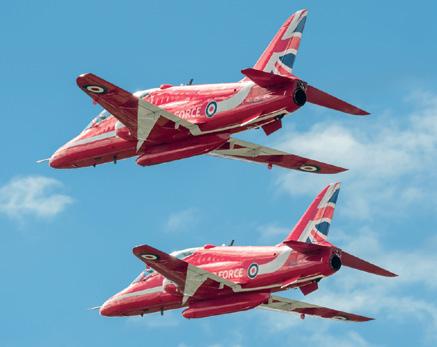
1. Aerial view of Scampton in 1918
2. A Lancaster overflies a Vulcan at RAF Scampton
3. A crashed Lancaster at RAF Scampton
4. V-Force era Vulcan from 27 Squadron
5. 617 Squadron Vulcan B2
6. Red Arrows Hawk jet
7. Vulcan on approach to RAF Scampton
8. V-Force Valiant overflies RAF Scampton
Scampton
During the early 1930s, as the threat of another European war loomed, it was announced that Scampton would be reopened and used as a bomber airfield
LOCATION / GRID REF:
Sheet 121 SK 952811 & SK 964796; located alongside the A15 Lincoln to Brigg road
DATES OF OPERATION:
1916 to 1919 – WWI home defence and training base
1936 to 1953 – bomber base
1952 to 1982 – jet bomber base
1983 to 2022 – training & home to the Red Arrows
SQUADRONS:
33(HD) Sqn; 11(R) Sqn; 60(R) Sqn; 81(R) Sqn; 34 TDS; 214 Sqn; 49 Sqn; 83 Sqn; 617 Sqn; 153 Sqn; 624 Sqn; 10 Sqn; 27 Sqn; 18 Sqn; 21 Sqn; 230 OCU; 35 Sqn; CFS; Red Arrows
In December 1916 as part of Britain’s Home Defence System, a Searchlight Unit was established at Aisthorpe Farm, Brattleby. With it came A Flight of 33 (HD) Sqn with FE2 pusher aeroplanes for anti-Zeppelin duties. The flight remained on the landing ground until June 1918 when it was posted to Manton to join the remainder of the squadron.
At the same time as 33 Sqn was establishing itself at Aisthorpe Farm it was decided to enlarge the flight station to form a new training aerodrome. Very soon its name was standardised as Scampton. Various training squadrons began to arrive at the aerodrome so that when on 1 April 1918 the Royal Air Force was formed, 11, 60 and 81 Reserve Squadrons amalgamated to form 34 TDS under the control of the 23rd Training Wing, with its headquarters at South Carlton. As soon as WWI ended 34 TDS began to run down, and by April 1919 the airfield had closed. Within a year all the buildings had been cleared and the site returned to agricultural use.
During the early 1930s, as the threat of another European war loomed, it was announced that Scampton would be reopened and used as a bomber airfield. The station was officially opened on 27 August 1936 and, with construction work still going on, the first flying units arrived; 9 Sqn from Aldergrove equipped with Heyfords, and 214 Sqn flying Virginias coming from Andover.
In March 1938, 9 and 214 Sqns were replaced by 49 and 83 Sqns equipped with Hind biplane light bombers. In September, 49 Sqn became the first RAF unit to operate the new Hampden. 83 Sqn soon followed; both squadrons were operational with the type by the time war was declared in September 1939 and took part in the first bombing missions of the war.
Throughout the summer of 1940 the intensity of air attacks increased. On 1 July the first 2,000lb bomb was dropped by an 83 Sqn Hampden piloted by F/O Guy Gibson. Number 12 Group Bomber Command’s first VC was awarded to Flt Lt Learoyd of 49 Sqn. He managed to fly his badly damaged aircraft back to Scampton after encountering severe enemy anti-aircraft fire of the Dortmund-Ems Canal. The second VC to be awarded to a Scampton airman went to Sgt John Hannah of 83 Sqn when, on 19 September 1940, he successfully extinguished a fire in his badly damaged Hampden.
83 Sqn began to convert to the Manchester during December 1941 and 49 Sqn followed suit in
West Lindsey | Scampton 29 West Lindsey | Scampton
28
1 2 3 4 5 6 8
7
April 1942. Both squadrons operated this ill-fated type until converting to the Lancaster in the summer of that year.
One of the most famous units of the RAF – 617 Sqn – was formed at Scampton on 21 March 1943. Formed for a special mission, the breaching of the Ruhr Dams, the new Squadron underwent a period of intensive training before setting out to attack the target on 16 May 1943. Two of the dams were breached with the loss of 8 of the force of 19 Lancasters dispatched. No less than 34 awards for bravery were awarded to the aircrew that took part in the mission, including the VC to the squadron’s commander, Wg Cdr Guy Gibson.
Scampton had been a grass airfield until the summer of 1943 when operations ceased and the airfield closed for the construction of concrete runways. By October 1944 the airfield was operational again and on the 15th of that month 153 Sqn brought its Lancasters from Kirmington. On 5 April 1945, 625 Sqn arrived from Kelstern, the Lancasters of both units taking part in their last operation of WWII later that same month.
With 153 and 625 Sqns disbanding at the end of September 1945 the station was earmarked for the Lincoln and in the late 40s and early 50s various units operated the type from the airfield. With the start of the Berlin Airlift and the worsening of east west relationships in June 1948, Scampton was one of the RAF stations made available to the US government as a heavy bomber base. B29 Superfortresses arrived in July and remained until January 1949, by which time international tensions had eased.
By 1953, with the Lincolns being phased out, Scampton had become a jet station as 10 Sqn had reformed and were equipped with Canberras on the airfield. Various other squadrons operated Canberras from Scampton until 1955 when in June the airfield was closed down for modernisation.
The next three years saw the base undergo a massive remodelling programme in preparation for use as a V-Bomber base. The old war-time three runway system was scrapped in favour of the single, long, main runway. So long in fact that the main A15 Lincoln to Brigg Road – the old Roman Ermine Street – had to be diverted. This is remembered now by the bow and arrow symbol on the station badge. In addition to the extended runway, much new technical and domestic accommodation was erected at the same time, extending the area of the airfield to over 900 acres.
With the airfield once again declared operational, 617 Sqn, reformed at Scampton on the 1 May 1958 with the Vulcan B1; over the next three years they were joined by 83 and 27 Sqns, with Vulcan B2s, bringing the Scampton Wing to full strength.
Scampton continued to be a front line Vulcan base until the Vulcan was phased out of service in 1982. With the disbanding of 27 Sqn on 31 March of that year, the V bomber era at Scampton finally came to an end.
After a period of uncertainty, it was announced that Scampton would transfer from Strike to Support Command and become the home of the CFS. The first part of the unit to move to Lincolnshire being the Red Arrows Aerobatic, which arrived in March 1983; they remained at the airfield until it officially closed in September 2022.
This site is currently inaccessible to the public. Please visit West Lindsey District Council’s website for the latest status.
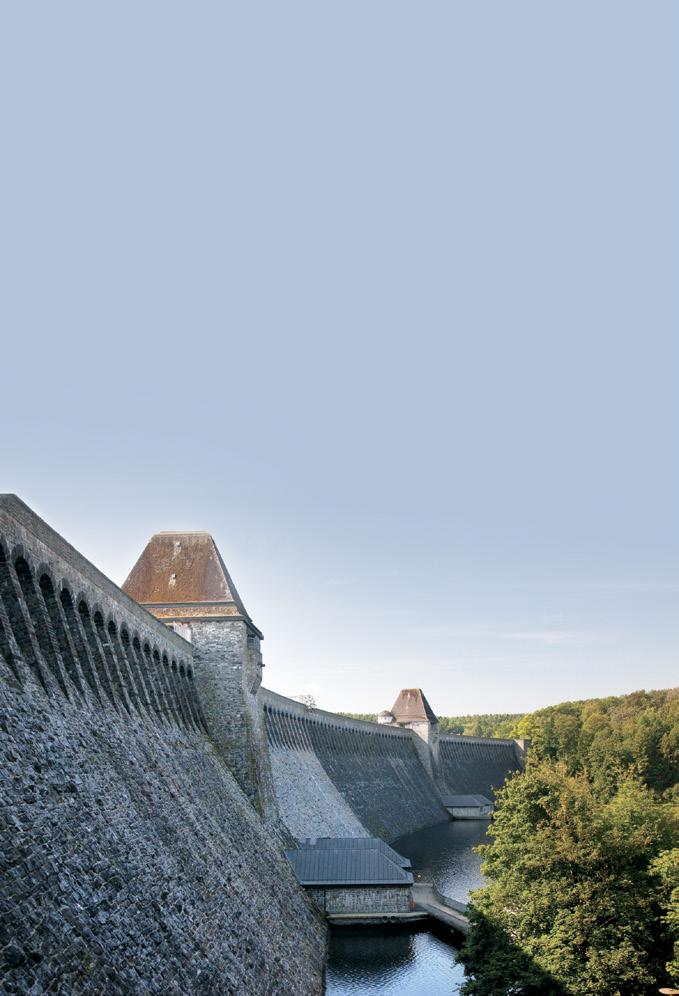
617 Squadron - The Dambusters
On the evening of 16th May 1943, 19 Avro Lancaster bombers, led by Wg Cdr Guy Gibson took off from RAF Scampton, bound for the Ruhr Valley – the industrial heartland of Nazi Germany.
They took a zig-zag route across the Netherlands and northern Germany, flying at less than 200 feet to avoid enemy defences, towards the huge dams of the Ruhr Valley. The first wave of aircraft approached the Möhne and Eder dams, and the second wave flew on to the Sorpe, Ennepe, Lister and Diemel dams.
Once at their targets, at a height of 60 feet and flying at precisely 220 mph, the bombers released the now famous ‘bouncing’ bombs. Designed by Dr Barnes Wallis, the five ton, drum shaped bomb travelled along a narrow angle of descent, hitting the water and bouncing or skipping along the surface in a ‘ducks and drakes’ fashion until it reached the dam where it sank. The water pressure set off the fuses and the bomb exploded, tearing a gigantic gap in the dam wall.
First the Möhne dam was breached, then the Eder – releasing millions of gallons of water (a 9ft wave of 100 million cubic metres of water tore through the Möhne Valley alone, killing some 1294 people and flooding towns and villages in its path). Hydro-electric turbines were ruptured, severing power to the Ruhr’s industries.
The second group of bombers approached the other 4 dams but only attacked the first two. The Sorpe was hit, but the breach was above water level. Operation ‘Chastise’ was a success and Guy Gibson was awarded the VC. The price of this success however was high, with 8 of the bombers failing to return and 53 of the original 133 crew lost.
West Lindsey | Scampton 31 West Lindsey | Scampton 30
SCAMPTON CHURCH & WAR
GRAVES HERITAGE CENTRE
LOCATION / GRID REF:
Sheet 121 SK 948795; on the B1398 Ingham road as you leave Scampton village
ADDRESS:
St. John the Baptist Church, High Street, Scampton, Lincoln, LN1 2SE
Telephone: 07534 025737
Email: info@scamptonchurch.org
Website: www.scamptonchurch.org
Opening hours: 10am to 4pm daily
Located on the High Street in Scampton Village, St. John the Baptist Church has traditionally displayed various memorial plaques and commemorative books associated with RAF Scampton and the north aisle houses the RAF Chapel. The churchyard contains 107 Allied and 8 German war graves.
In recent years, thanks to the support of Heritage Lincolnshire, a formal Heritage Centre has been established in the church. This is supported through a diverse set of education resources
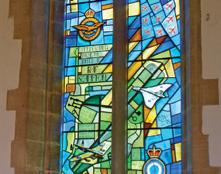
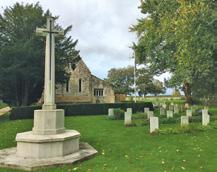
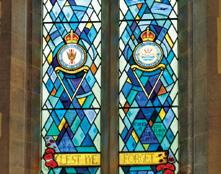
and interactive displays, which enables the volunteers to offer free school sessions aimed at primary school pupils learning about WWII and the county’s part in international history.
The church also has two stunning stained glass windows by Claire Williamson that commemorate the area’s aviation heritage, both funded by major fund raising campaigns and donations. The dedication service for the RAF Scampton Commemorative Stained Glass Window took place in September 2022, at the time of the formal closure of RAF Scampton. The 617 Squadron Stained Glass Window was installed and dedicated in spring 2023.
1. RAF Scampton Commemorative Stained Glass Window
2. The approach to St John the Baptist Church
3. 617 Squadron Stained Glass Window
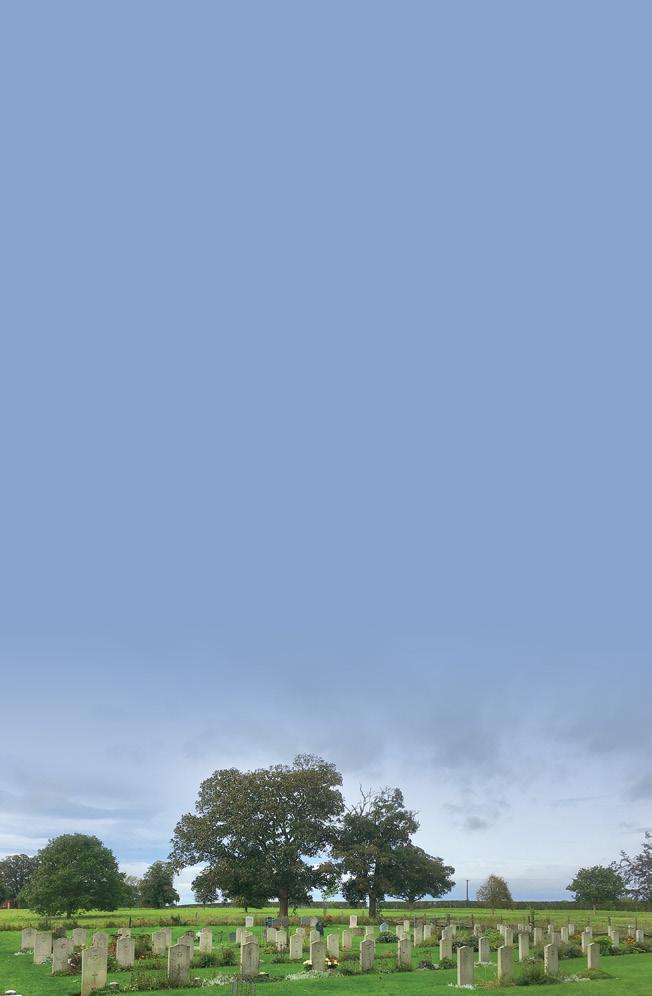
WELTON CHURCH
LOCATION / GRID REF:
Sheet 121 SK 012798; In the centre of Welton village
ADDRESS:
St Mary’s Church, Lincoln Road, Welton, Lincolnshire, LN2 3LT
Located on Lincoln Road in the centre of Welton village, on the approach to St Mary’s church you pass a war memorial that was erected in the early 1920s and the former flag mast from RAF Scampton, which was relocated to the churchyard in 1997.
Various memorials to war heroes are found within the church. A brass plaque records the names of those who lost their lives in WWI and a stained glass window, installed in 1921 commemorates the RNAS, RFC and RAF personnel who served in the same war.
In the nearby village of Dunholme, St Chad’s church (Sheet 121 SK025794) houses a memorial plaque, which is dedicated to 44 (Rhodesia) Squadron.
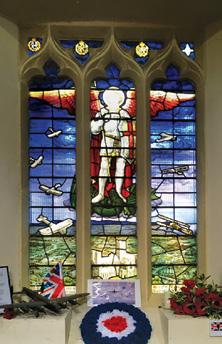
2. The front of St Mary’s Church with the former RAF Scampton flagpole 1
1. Commemorative Stained Glass Window
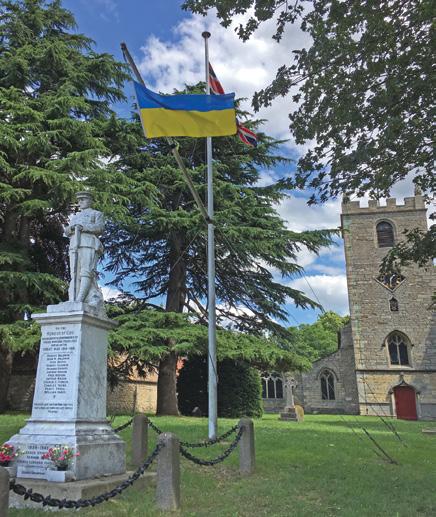
West Lindsey | Welton 33 West Lindsey | Scampton 32
2 1 2 3
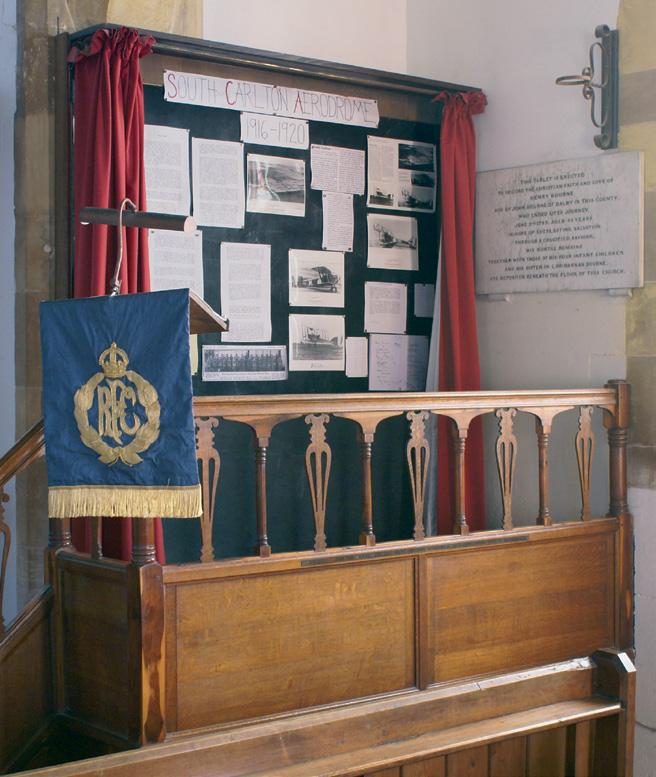
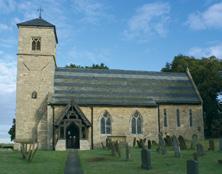
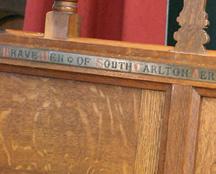
69 Squadron AFC, which had formed in Egypt, was transferred to South Carlton in December 1916 and with RE8s worked up as a reconnaissance unit
LOCATION / GRID REF: Sheet 121 SK 951767; the village is located off the B1398 Lincoln to Ingham road
DATES OF OPERATION:
1916 to 1920 – WWI training base
SQUADRONS:
39 Sqn; 45 Sqn; 61 Sqn; 69 Sqn (AFC); 46 TDS;34 TDS
During WWI, with increasing losses of operational pilots over the battle front, many new aerodromes were established throughout England and early in 1916 South Carlton was opened as a training station.
39, 45 and 61 Training Squadrons were moved onto the aerodrome and with various types of aeroplane, began the task of training pilots for fighter and reconnaissance duties.
69 Squadron AFC, which had formed in Egypt, was transferred to South Carlton in December 1916 and, with RE8s, worked up as a reconnaissance unit before being posted to France in September 1917. This squadron later became the squadron responsible for the autopsy and burial of the German WWI fighter ace the ‘Red Baron’.
In July 1918 the training squadrons for South Carlton were amalgamated to form No 46 TDS, and along with 34 TDS at Scampton, became the 23rd TW. With the close down of Scampton in April 1919 the aeroplanes of 34 TDS were transferred to the strengths of 46 TDS. However with the end of the war 46 TDS was also run down and subsequently disbanded in April 1920.
Although the aerodrome was closed down in the 20’s several buildings still exist on the site, now being used as farm stores and are not accessible to the general public. A carved pulpit was installed in St John the Baptist Church, South Carlton. This features a thin brass plaque, which acts as a memorial to the men of the RFC and RAF who lost their lives flying from the aerodrome.
1. Commemorative display behind the carved pulpit at St John the Baptist Church
2. South Carlton church
3. RFC / RAF memorial plaque on the pulpit
West Lindsey | South Carlton 35 West Lindsey | South Carlton 34 1 2 3
South Carlton
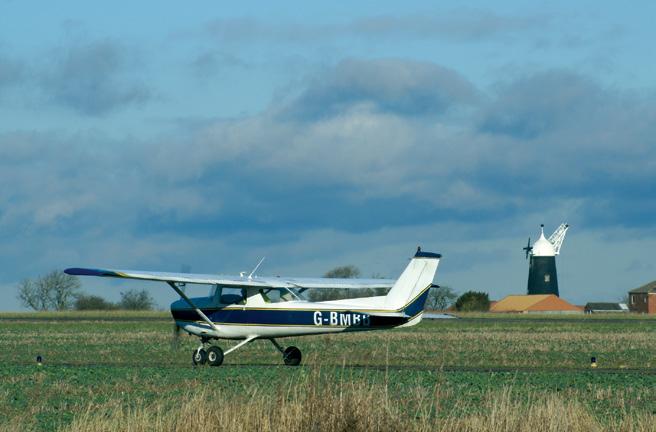
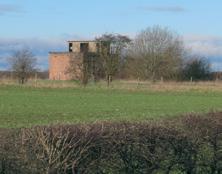
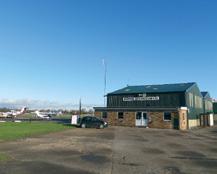
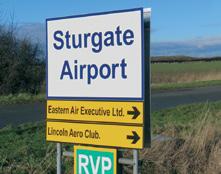
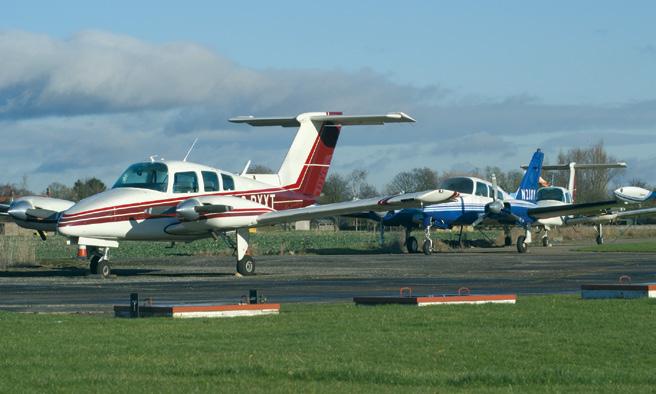
Sturgate was opened in 1944 as a bomber base within No. 1 group, Bomber Command
LOCATION
Sheet 121 SK 877878; South east of Gainsborough, between the villages of Upton and Heapham
DATES OF OPERATION:
1944 to 1946 – WWII training base
1953 to 1958 – USAF base
1969 to current – Civilian flying
SQUADRONS:
1520 BAT; 1 ACS; 50 Sqn; 61 Sqn; 3928 ABG
1. A light aircraft prepares to take off at Sturgate
2. A disused wartime building at Sturgate
3. Hangars & workshops at Sturgate
4. Airfield entrance to Sturgate
5. Some of Sturgate’s thriving aviation community
Sturgate is a former WWII airfield that, unlike many of its contemporaries, has maintained its aviation connections, albeit as a civilian airfield.
Sturgate was opened in 1944 as a bomber base within No. 1 Group, Bomber Command, but it seems doubtful that any operations were dispatched from its runways, being used until the end of the war for training purposes.
The airfield’s first unit was 1520 BAT Flight, which arrived from Leconfield in September 1944; to be joined in November by No. 1 Group ACS. In February 1945 the BAT Flight disbanded and in May ACS left the station to be replaced in June by 50 and 61 Sqns, who flew their Lancasters from Sturgate until January 1946. With the squadrons gone the airfield was placed on Care and Maintenance until the early 50’s.
With the onset of the cold war and the deployment of American forces in Britain, in June 1953 Sturgate was allocated to the USAF. Number 3928 ABG, part of the 7th Air Division of SAC, was formed on the airfield. Flying was very limited, despite many thousands of dollars being spent rebuilding runways and other facilities; although on one occasion a squadron of RF-84 jet fighters deployed on the airfield for a short time. In 1958 the airfield was handed back to RAF control, although used as a supply base by the Americans until 1964. The site was disposed of by the Ministry in 1965.
Civilian flying began at Sturgate in 1969 with the beginning of a charter and taxi operation using a Piper Aztec Aircraft. The airport has grown and today is a thriving centre for civil aviation.
West Lindsey | Sturgate 37 West Lindsey | Sturgate 36
Sturgate
/ GRID REF:
1 2 3 4 5
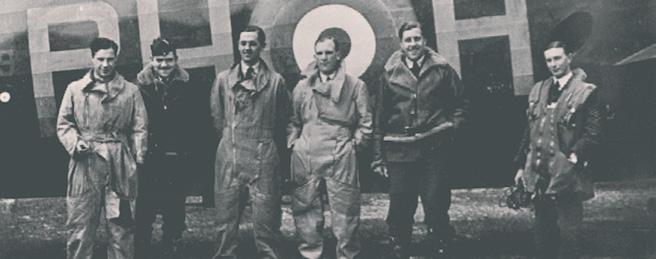
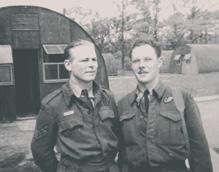
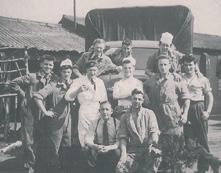
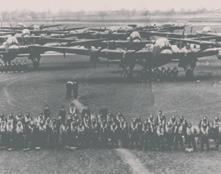
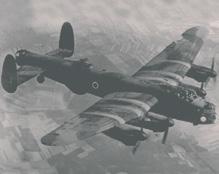
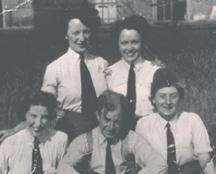
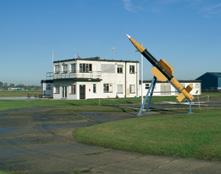
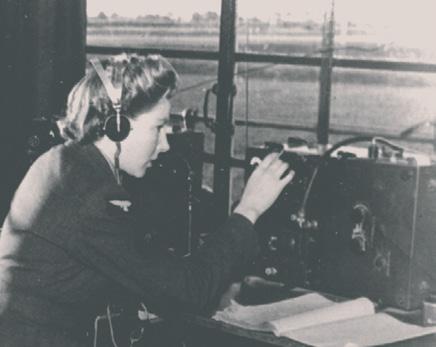
1. Crew of Wellington II PH-H W5419
2. Sgt Hannah & F/Sgt McDevitt
3. Wickenby WAAFs
4. Wickenby’s watch office still in use
5. Building on the left, Airmen’s Mess and Cookhouse entrance; building on the right camp cinema (the Rex)
6. WAAF Wireless Operator
7. RAF Wickenby Lancasters and crews
8. Lancaster PH-U
Wickenby
Work had been completed by the autumn of 1942 and, on 25 September, 12 Sqn moved with its Wellingtons from Binbrook
LOCATION / GRID REF:
Sheet 121 SK 102809; the RAF Wickenby Memorial is well signed posted from the junction of the A158 and the B1399 roads
DATES OF OPERATION:
1941to 1945 – WWII bomber base
1946 to 1956 – Maintenance Unit & munitions storage
1960s to current – Civilian flying
SQUADRONS:
12 Sqn; 626 Sqn; 93 MU
The contractors McAlpine moved to Wickenby late in 1941 and began to construct a bomber airfield for No. 1 Group, Bomber Command. Work had been completed by the autumn of 1942 and on 25 September 12 Sqn moved with its Wellingtons from Binbrook. In November Lancasters replaced the Wellingtons, the squadron using its new aircraft for the first time during January 1943.
In November 1943 C Flt of 12 Sqn was detached to form an operational nucleus for 626 Sqn which formed at Wickenby. Together the two units operated the Lancasters in the bomber offensive until the end of the war. They also dropped food supplies as part of Operation Manna and repatriated POWs as part of Operation Exodus. In July 1945 12 Sqn returned to Binbrook and 626 Sqn disbanded on the 14 October.
Wickenby was then transferred to 40 Group, MC, and became the home of 93 and 92 MUs. For a number of years the unit used the war time runways for the storage of many thousand surplus bombs, the majority of which were disposed of safely in the sea during the early 50’s.
Wickenby closed down in 1956 and by the mid 60’s had been disposed of, the majority of which returned to agriculture, although the war time control tower and surrounding area are used by a private flying group and many other companies.
The airfield is home to the RAF Wickenby Memorial Collection, an aircraft engineering company and a thriving light aircraft community.
West Lindsey | Wickenby 39 West Lindsey | Wickenby 38
1 2 3 4 5 6 8 7
RAF WICKENBY MEMORIAL COLLECTION
LOCATION / GRID REF:
Sheet 121 SK 104810; the RAF Wickenby Memorial is well signed posted from the junction of the A158 and the B1399 roads
ADDRESS:
RAF Wickenby Memorial Collection, The Control Tower, Wickenby Aerodrome, Langworth, Lincoln LN3 5AX
Telephone No: 01673 885000
Email: wickenbymuseum@outlook.com
Website: www.wickenbymuseum.co.uk
Opening hours:
1 April to 31 October - 9am to 5pm daily
1 November to 31 March - 9am to 4pm daily
Admission fees: Visitor Centre – free admission
Other Locations
Blyborough
LOCATION / GRID REF:
Sheet 112 SK 953937
A Class 1 night landing ground was established at Blyborough for 33 (HD) Sqn during the period it was operational in North Lincolnshire from December 1916 to early 1918. This location is now farmland, which lies between the B1398 and A15 roads.
Cockthorne
LOCATION / GRID REF:
Sheet 121 SK 069875
Housed on the first floor of the watch office, the RAF Wickenby Memorial Collection commemorates all who served at RAF Wickenby from 1942 – 1956; especially the 1,146 aircrew who failed to return from operational sorties in WWII. The displays feature interesting artefacts related to RAF Wickenby, 12 Sqn, 626 Sqn and the Lancaster bomber and its crews.
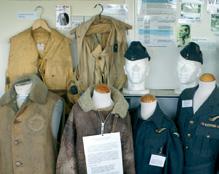
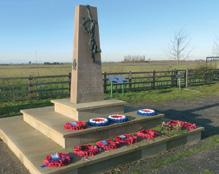
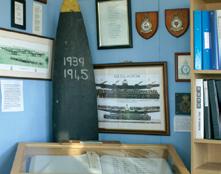
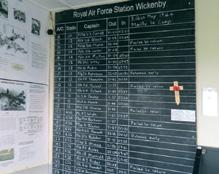
The archive was originally started by the Wickenby Register, but recently it has more than doubled in size, due to the work and research of the RAF Wickenby Memorial Collection. Much of the archive has been digitised and cross referenced. This enables searches to be made using a person’s name, crew members or plane to find all relevant documents and photographs. Research visits to access the archive by appointment only.
Wickenby has been an active civil airfield since the 1960s and today it is home to an active flying club. At the entrance to the airfield is an impressive memorial stone that features the badges of 12 Sqn and 626 Sqn; and a representation of Icarus. The RAF Wickenby Walk is a line of trees and plaques, from the memorial along to the watch office, that has been planted in memory of RAF Wickenby’s veterans.

A Class 2 landing ground was established at Cockthorne Farm for 33 (HD) Sqn from December 1916 to June 1919. Originally it was only used by day, but lighting, consisting of petrol soaked rags in tin cans, was provided during the latter part of the war. This location is now farmland, which lies west of the A46 road.
Cuxwold
LOCATION / GRID REF:
Sheet 113 SK 185010
This Class 2 night landing ground was used by 33 (HD) Sqn from December 1916 to June 1919. The site which covered some 80 acres was the target for bombs from the Zeppelin L46 on the night of 24 September 1917. Attracted by the lights of flares marking the landing area, bombs fell in surrounding fields without causing damage. This location is now farmland, which lies south east of the A46 road.
Kexby
LOCATION / GRID REF:
Sheet 122 SK300655
The scene of a Lancaster Bomber flying over the Lincolnshire countryside during WWII was painted on the wooden wall of the original
Kexby /Upton village hall which, at that time, was being used as a Naafi Club. The painting is thought to have been the backdrop to the stage used by the servicemen for entertainment. It is signed by the artist R S Thomas and dated 1944.
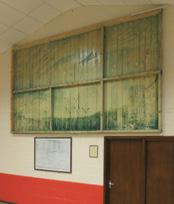
Hidden for many years under a false wall, the painting was re-discovered when the building was being prepared for demolition in 1987. The village hall committee offered the mural for display to the Battle of Britain Memorial Flight Museum at RAF Coningsby where it remained for the next three years. In 1990 it was decided that the painting should return to its original site, to the new village hall at Upton/Kexby.
Laughterton
LOCATION / GRID REF:
Sheet 121 SK 838761
Located in Laughterton on the junction of A1133 road with road to Kettlethorpe / Fenton is the appropriately named Propeller Island, which is the location for the village’s RAF Memorial. This takes the form of a single blade from an Avro Lancaster bomber set in a simple stone cairn.
This memorial was dedicated at a ceremony held on 16 July 1994. Unusually, it commemorates the 50th anniversary of the deaths of the crew of two RAF bombers –Stirling EH940 from 1661 HCU RAF Winthorpe; and Lancaster LM29, from 103 Sqn RAF Elsham Wolds; both aircraft crashed near to the village in the summer of 1944.
West Lindsey | Wickenby 40
West Lindsey | Other Locations 41
Other Memorials
Bransby
LOCATION / GRID REF:
Sheet 121 SK 900793
A memorial plaque in memory of 49 Sqn crew of Hampden lost out of RAF Scampton 25 January 1942 can be found in a shelter in the Peter Hunt Memorial Garden at the Bransby Horses Centre. The plaque was dedicated on 25 January 1992. https://bransbyhorses.co.uk/
East Stockwith
LOCATION / GRID REF:
Sheet 112 SK 790946

Adjacent to the cemetery in Laughton Woods a gum tree was planted to commemorate the crew of Lancaster W4314 lost on 1st September 1943 while operating out of nearby RAF Blyton with 1662 HCU. The aircraft was lost at 0325 hours while on night cross-country exercise; all 7 crew were killed including 4 Australians.
Caistor
LOCATION / GRID REF:
Sheet 112 SK 094016
Surrounding Aviation Sites
Battle of Britain Memorial Flight Visitor Centre
Dogdyke Road, Coningsby, LN4 4SY
Tel: 01522 782040
Email: bbmf@lincolnshire.gov.uk
Web: www.lincolnshire.gov.uk/bbmf
Cranwell Aviation Heritage Museum
North Rauceby, Sleaford NG34 8QR
North Lincolnshire Aviation Heritage Centre
Field House Farm, Redbourne Road, Hibaldstow, Brigg, North Lincolnshire, DN20 9NN
Email: nlahc@outlook.com
Web: www.nlahcentre.com
RAF Cranwell Heritage & Ethos Centre*
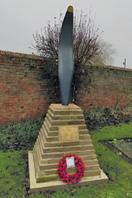
A memorial has recently been raised on the corner of Back Street and St Peters Close in Stockwith to the memory of the crew of Lancaster ME323, PH–P of 12 Sqn flying out of RAF Wickenby on 4 March 1945. The aircraft was shot down by an intruder during night training flight at 0110 hours and all seven crew were killed. The memorial incorporates a propeller recovered from crash site and it was dedicated in summer 2018.
Laughton
LOCATION / GRID REF:
Sheet 112 SK 848976
Located in the village cemetery a memorial sundial on a blue/grey plinth was raised in 2005; its inscription reads: “Remembering aircrew who lost their lives in this area during WWII. This memorial was placed here by Laughton Parish on 5th June 2005.
“Lest We Forget”
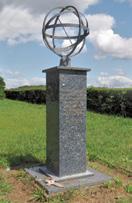
This memorial plaque is affixed to the low garden wall of a house on the south side of Caistor to North Kelsey road, near to the hamlet of North Kelsey Moor. The memorial was dedicated 5th April 2014 and commemorates the loss of Lancaster R5672 on 8th April 1944. The aircraft was based at No 1 LFS at RAF Hemswell. Nine people were killed in the crash, including a female ATA pilot and several members of ground crew.
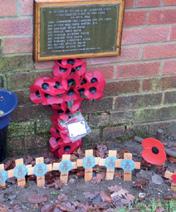
Tel: 01529 488490
Email: cranwellaviation@n-kesteven.gov.uk
Web: www.heartoflincs.com/cranwell
International Bomber Command Centre
Canwick Hill, Lincoln, LN4 2HQ
Tel: 01522 514755
Email: info@internationalbcc.co.uk
Web: www.internationalbcc.co.uk
Lincolnshire Aviation Heritage Centre
East Kirkby Airfield, Nr Spilsby, Lincolnshire, PE23 4DE
Tel: 01790 763207
Email: enquiries@lincsaviation.co.uk
Web: www.lincsaviation.co.uk
Market Rasen
LOCATION / GRID REF: Sheet 113 SK106887
On 9th May 2010 a memorial plaque on the wall of the Market Rasen Railway Station was dedicated to the five man crew of Valiant, V-bomber, WZ363 from 207 Squadron at RAF Marham, Norfolk, that was lost on 6th May 1964. The aircraft crashed close to West Farm on the Linwood Road and burst into flames, shortly after it had undertaken a practice “roller landing” at RAF Binbrook during a low-level training flight.
A flower planter and memorial painting are also now located adjacent to the plaque.
Metheringham Airfield Visitor Centre
Martin Moor, The Visitor Centre, Westmoor Farm, Metheringham, Lincoln, LN4 3WF
Email: enquiries@methinghamairfield.co.uk
Web: www.metheringhamairfield.co.uk
Newark Air Museum
Drove Lane, Winthorpe, Newark, Nottinghamshire, NG24 2NY
Tel: 01636 707170
Email: enquire@newarkairmuseum.org
Web: www.newarkairmuseum.org
10 Cranwell Ave, Cranwell Village, Sleaford, Lincolnshire, NG34 8HG
Email: CRN-RAFCranwell-Heritage@mod.gov.uk
RAF Digby Lima Sector Operations Museum*
Ashby-de-la-Launde, Lincoln, Lincolnshire, LN4 3LH
Tel: 01526 327429
Email: digbymuseum@aol.com
RAF Waddington Heritage Centre*
High Dyke, Lincoln, Lincolnshire, LN5 9NB
Tel: 01522 728288
Email: WAD-Station-Enquiries@mod.gov.uk
Thorpe Camp Visitor Centre
Woodhall Spa Road, Tattershall Thorpe, Lincolnshire, LN4 4PE
Tel: 07396 228655
Email: thorpecampvc@gmail.com
Web: www.thorpecamp.org
We’ll Meet Again Museum
Shore Road, Freiston, Boston, Lincolnshire, PE22 0LY
Tel: 01205 761082
Web: www.wma-ww2museum.co.uk
*Due to the nature of the location, pre-booking is required.
West Lindsey | Surrounding Aviation Sites West Lindsey | Other Memorials





















































































































